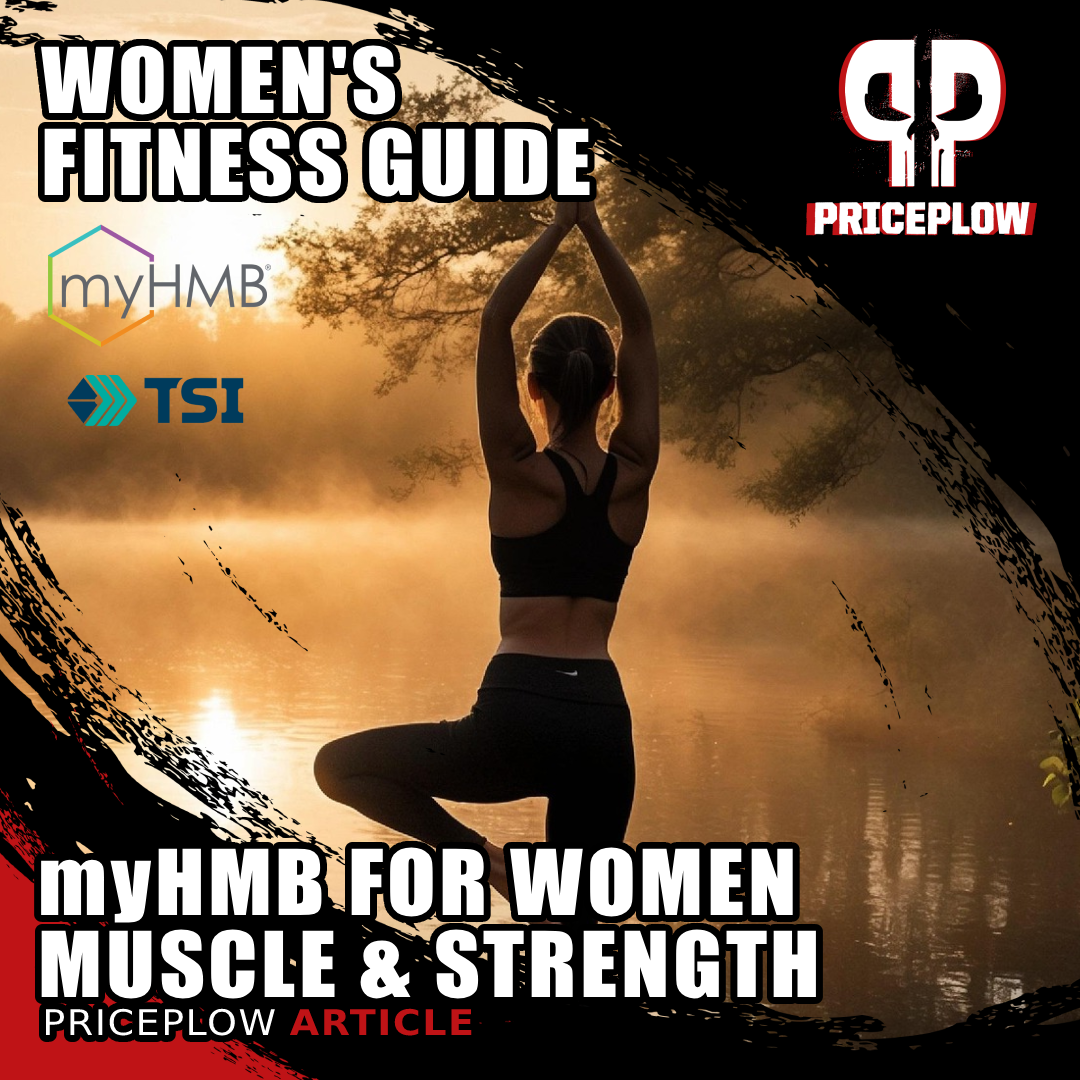
Afraid of getting bulky? Women produce 15-20x less testosterone than men. Research shows myHMB helps you build lean muscle and preserve strength during fat loss and menopause without bulking up.
Walk into any gym and you'll notice a pattern: men dominate the free weight section while women cluster around cardio equipment. Ask why, and you'll often hear the same concern: "I don't want to get bulky."
The "Bulking Up" Myth (and Why You're Missing Out)
This fear keeps countless women from one of the most effective health interventions available: resistance training. The irony? The physiological reality makes significant muscle growth extremely difficult for women without extreme measures (or "hormonal enhancement").
Reason being, women produce roughly 15-20 times less testosterone than men.[1] This difference means building large, "bulky" muscles is far less likely in women without more extreme interventions. For the average woman following a reasonable training program, strength training produces something far better than bulk: toned, defined muscles that improve metabolism, bone density, and functional strength.
The benefits extend well beyond aesthetics. Muscle tissue serves as your body's primary site for insulin-stimulated glucose uptake, making it essential for blood sugar regulation.[2] It functions as an amino acid reservoir during illness or stress, supplying the raw materials your body needs for recovery.[3] Through mechanical forces and chemical signaling, muscle stimulates bone remodeling and increases bone mineral density, factors women ignore at their peril, given their four-times-higher risk of osteoporosis.[4]
myHMB: The Missing Part of the Muscle Preservation Plan for Women
Sold as myHMB by TSI Group, HMB (β-hydroxy β-methylbutyrate) amplifies these benefits. As a metabolite of the essential amino acid leucine, HMB works through a dual mechanism: increasing muscle protein synthesis while simultaneously decreasing muscle protein breakdown. This one-two punch makes HMB valuable for women navigating the unique challenges of building and maintaining muscle mass.
In this article, we explore the benefits of myHMB supplementation, given specific thought to women. We explain the background, and look at research conducted specifically on women showing the great benefits of this powerful muscle-supporting ingredient for females. Before diving in, sign up for our myHMB and TSI Group news alerts so you don't miss any future research or product launches:
Subscribe to PricePlow's Newsletter and Alerts on These Topics
Why Muscle Health Matters More Than You Think
Most discussions about women's health focus on cardiovascular fitness, bone density, or body weight. The trend is changing, but muscle health still rarely gets top billing. Yet muscle mass functions as a keystone of overall wellbeing, influencing everything from metabolic function to longevity.
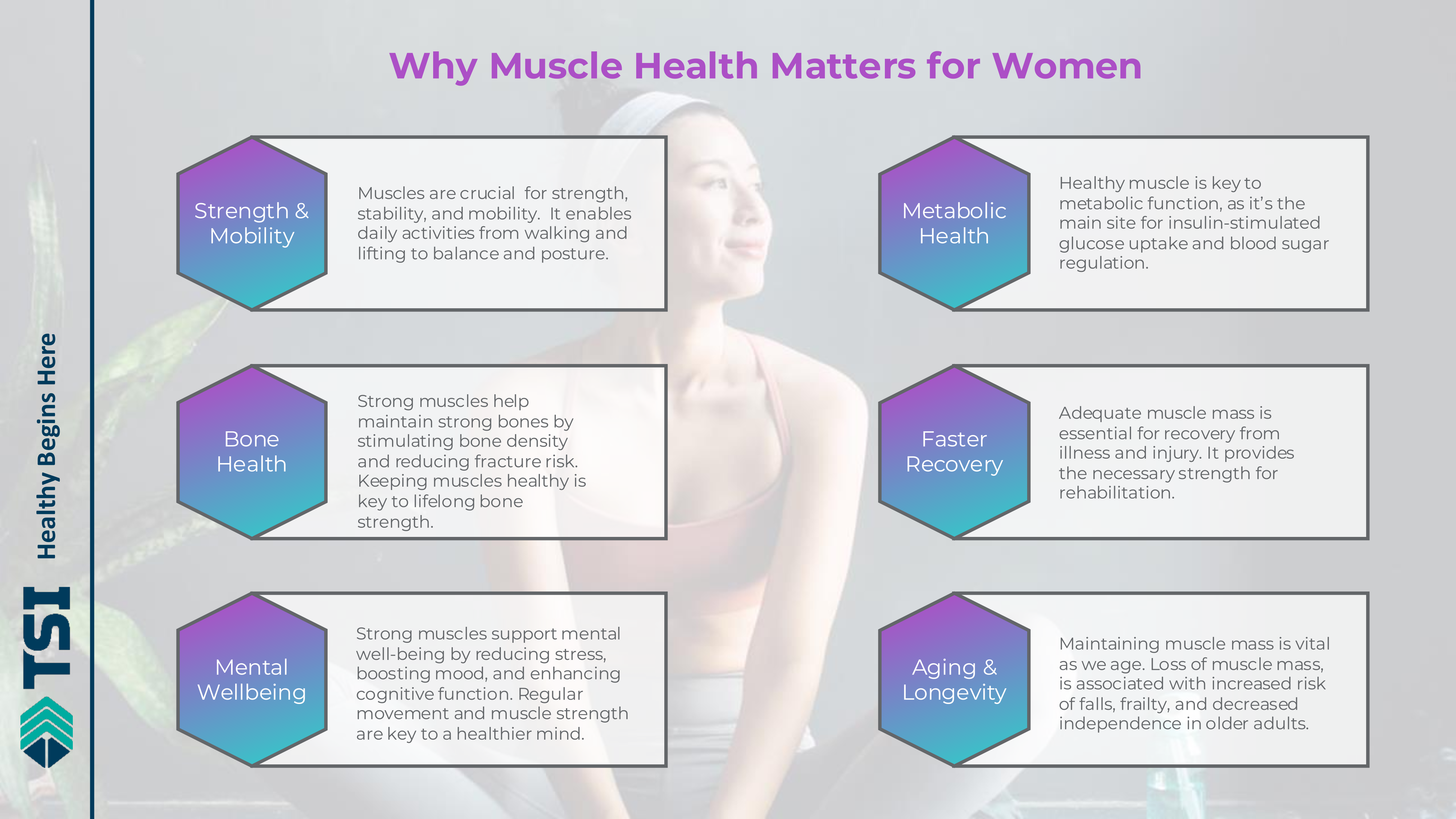
From daily strength and mobility to metabolic function and healthy aging, muscle tissue serves as the foundation for women's long-term health across multiple body systems.
The Metabolic Engine
Skeletal muscle accounts for approximately 30-40% of body mass in healthy adults, making it the largest insulin-sensitive tissue in the body.[2] After you eat a meal containing carbohydrates, your muscles perform the heavy lifting of glucose disposal, pulling sugar from your bloodstream and storing it as glycogen or burning it for energy. When muscle mass declines, this metabolic capacity diminishes, increasing the risk of insulin resistance and metabolic dysfunction.
Muscle tissue burns more calories at rest than fat tissue, contributing to your basal metabolic rate. While the difference isn't as dramatic as some sources claim (roughly 6 calories per pound of muscle versus 2 calories per pound of fat daily), the cumulative effect over time influences body composition and metabolic health.[5]
The Protein Reserve
During periods of illness, injury, or extreme stress, your body requires amino acids for tissue repair, immune function, and healing. Where does it find them? Your skeletal muscle serves as the primary protein reserve, breaking down muscle tissue to supply these critical building blocks.[3]
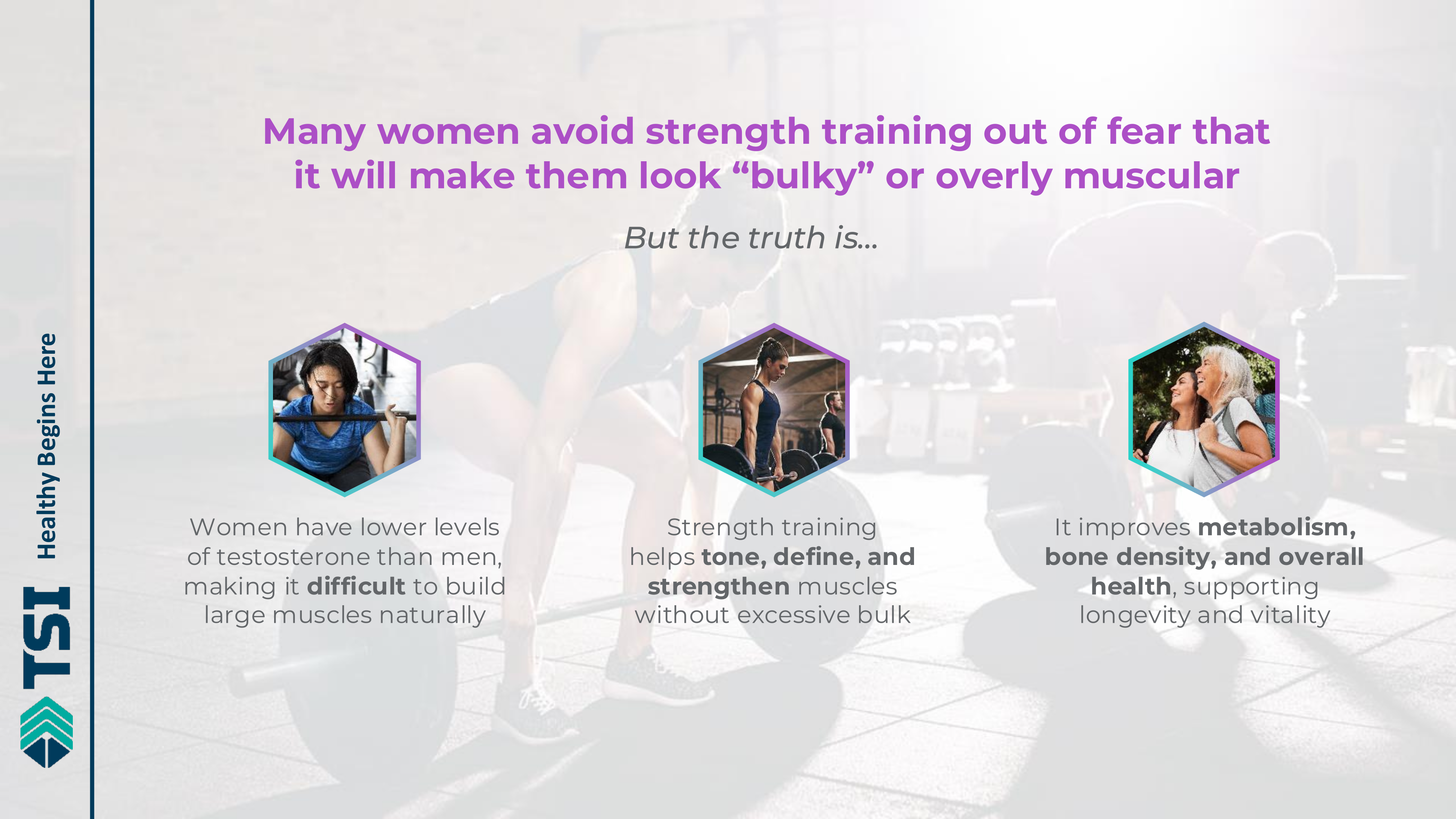
Three key truths about women and resistance training: lower testosterone makes excessive muscle growth unlikely, strength training creates lean definition rather than bulk, and the health benefits extend far beyond appearance to metabolism and bone density.
Women with greater muscle mass enter these stressful periods with more reserves, enabling faster recovery and better outcomes. Those with low muscle mass find themselves at a significant disadvantage, with inadequate protein stores to support healing processes.
The Bone-Building Connection
Bone density and muscle mass share an intimate relationship. When muscles contract, they pull on bones, creating mechanical stress that stimulates bone remodeling and increases mineral density.[4] Muscle tissue also releases signaling molecules that communicate with bone cells, further influencing skeletal health.
For women, this connection becomes critical during and after menopause. The same hormonal changes that accelerate muscle loss also increase bone loss, creating a vicious cycle. Women face a four-times-higher risk of osteoporosis than men, making muscle preservation not just beneficial but essential for skeletal integrity.
The Gender Gap in Muscle Mass
Research using whole-body MRI scans reveals the stark reality: women possess significantly less muscle mass than men at every age.[6] In a study of 468 healthy adults, men averaged 33 kilograms of skeletal muscle compared to just 21 kilograms in women -- a 57% difference! When normalized to body weight, muscle comprised 38% of men's body mass versus 31% in women.
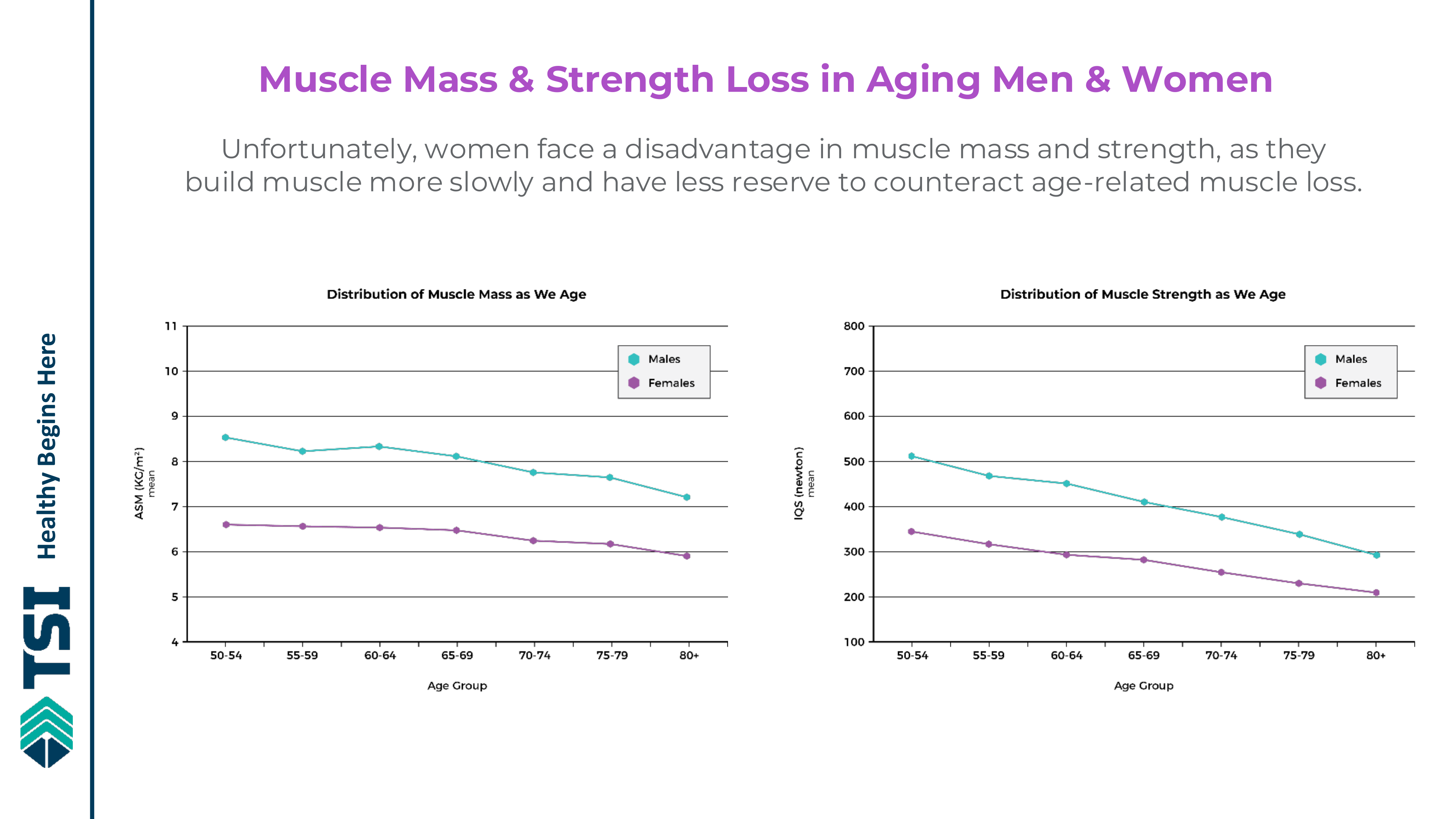
Two comparative graphs reveal that women start with less muscle mass than men and experience similar rates of decline, creating a more challenging situation for maintaining strength and function with age.
These differences proved even more pronounced in the upper body, where men possessed 40% more muscle mass than women, compared to a 33% difference in the lower body. This distribution explains the well-documented strength disparities between sexes.
Starting with less muscle mass means women have less reserve to lose as they age. Every kilogram of muscle lost has a proportionally greater impact on strength, function, and metabolic health. This reality makes proactive muscle preservation strategies essential, not optional.
The Female Muscle Loss Timeline
Muscle mass peaks around age 30, establishing the maximum reserve most women will ever achieve. From there, the trajectory trends downward... slowly at first, then with increasing speed.
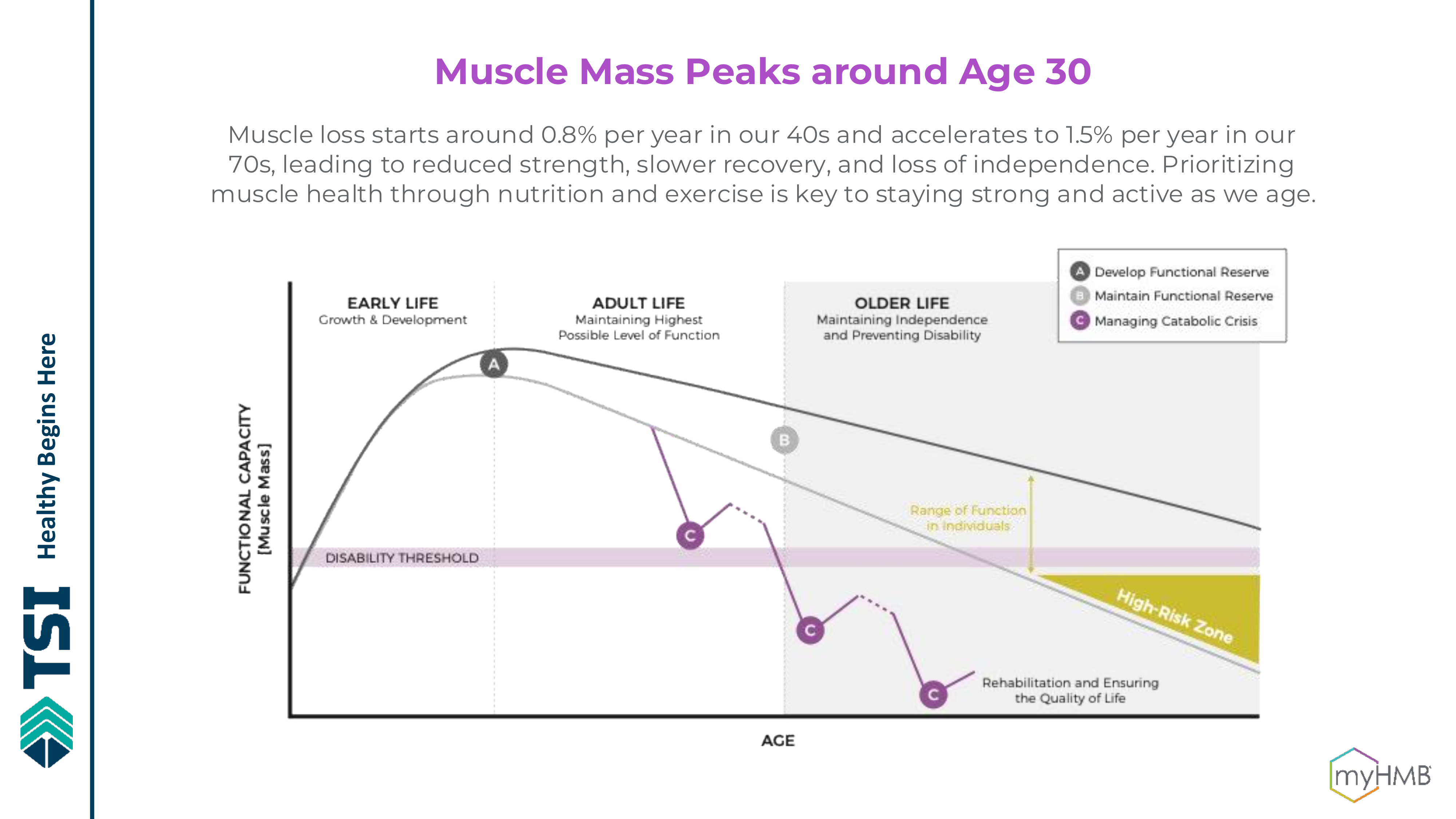
Chart showing muscle mass peaks around age 30 with three life phases: early development, adult maintenance, and older adult independence prevention, including disability threshold and high-risk zones.
The Subtle Decline: Ages 30-50
Muscle loss begins earlier than most women realize. Throughout the fourth decade of life, relative muscle mass starts declining, though absolute muscle mass may remain stable until around age 45-50.[6] During this period, muscle loss proceeds at approximately 0.8% per year, which is enough to notice in hindsight, but subtle enough to ignore in the moment.
Sedentary lifestyles accelerate this decline. Modern life, with its desk jobs and screen time, provides few opportunities for the muscle-stimulating activities our bodies evolved to expect. Without deliberate resistance training, women lose roughly 1.1 kilograms of muscle per decade during middle age.[6]
The Acceleration: Post-Menopause
Menopause marks a turning point in muscle health. The decline in estrogen levels that defines this transition affects far more than reproductive function: it fundamentally alters how the body builds and maintains muscle tissue.[7]
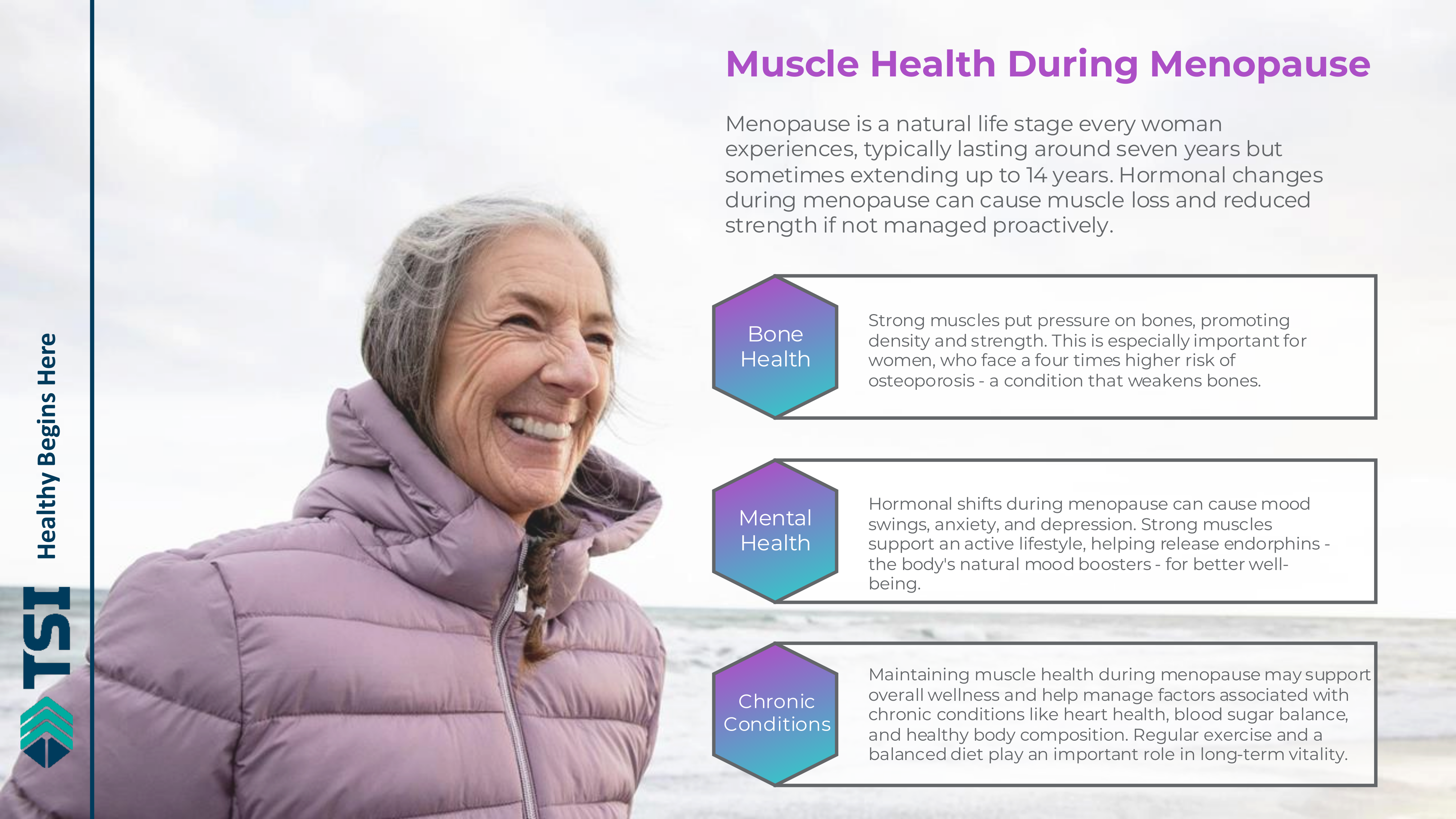
Educational graphic explaining how menopause affects muscle through hormonal changes, with focus on bone density maintenance, mood regulation through endorphins, and chronic disease prevention.
Postmenopausal women lose muscle mass at an accelerated rate, with some studies documenting losses up to 1.5% per year in the seventh decade of life. The decline affects the lower body disproportionately, resulting in reduced leg strength, slower gait speed, and increased fall risk.
This accelerated muscle loss occurs alongside decreased bone density, creating a dangerous combination. Weaker muscles provide less mechanical stimulus for bone building, while lower bone density increases fracture risk. Falls that younger women might walk away from can result in life-altering injuries.
The Consequences Cascade
Muscle loss triggers a cascade of negative effects that compound over time:
- Reduced Strength and Function: Tasks that once seemed trivial (carrying groceries, climbing stairs, getting up from a chair) become more challenging. This functional decline often marks the beginning of dependence on others for daily activities.
- Metabolic Slowdown: Lower muscle mass reduces basal metabolic rate, making weight management increasingly difficult. Many women find themselves gaining fat mass even as their muscle mass declines, resulting in a particularly unhealthy body composition shift.
- Increased Fall Risk: Weaker legs and reduced balance increase the likelihood of falls. For women with compromised bone density, these falls frequently result in fractures, with hip fractures carrying the most devastating consequences for independence and longevity.
- Chronic Inflammation: Muscle loss associates with elevated levels of inflammatory markers in the bloodstream. This low-grade chronic inflammation contributes to numerous age-related diseases, including cardiovascular disease, type 2 diabetes, and cognitive decline.[8]
- Loss of Independence: The endpoint of unchecked muscle loss is frailty and dependence. Women who fail to maintain muscle mass face increased risk of disability, institutionalization, and reduced quality of life in their later years.
The good news? This trajectory isn't inevitable. Resistance training and strategic nutrition -- including HMB supplementation -- can slow, stop, or even reverse muscle loss at any age.
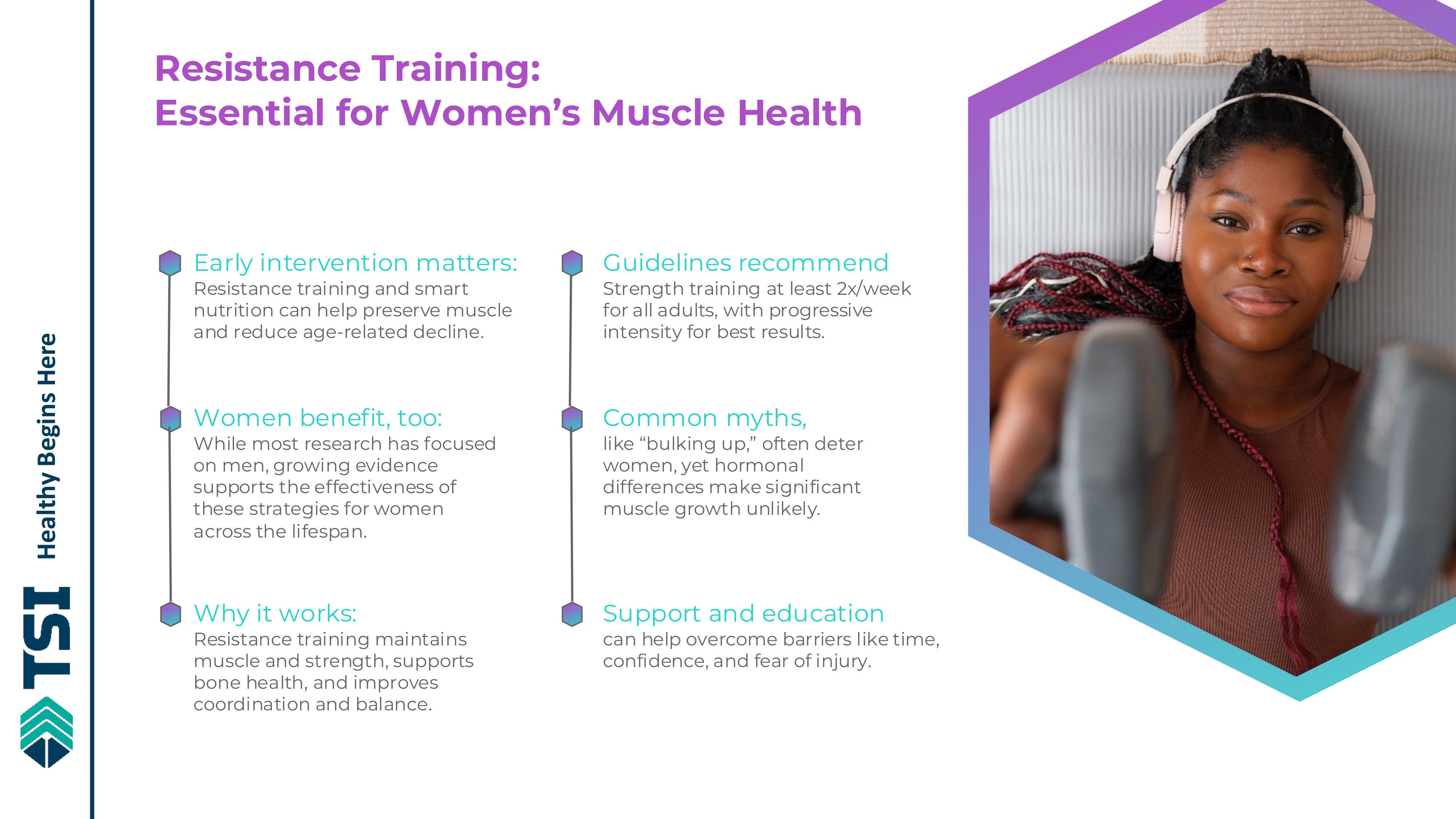
Educational layout covering early intervention benefits, official exercise recommendations, research evidence for women, and addressing common myths about "bulking up" fears.
What HMB Does (and Why Women Need It)
HMB, short for β-hydroxy β-methylbutyrate, is a metabolite produced when your body breaks down the branched-chain amino acid leucine. While your body produces small amounts of HMB naturally from dietary protein, supplementation provides concentrated doses that drive meaningful physiological effects.
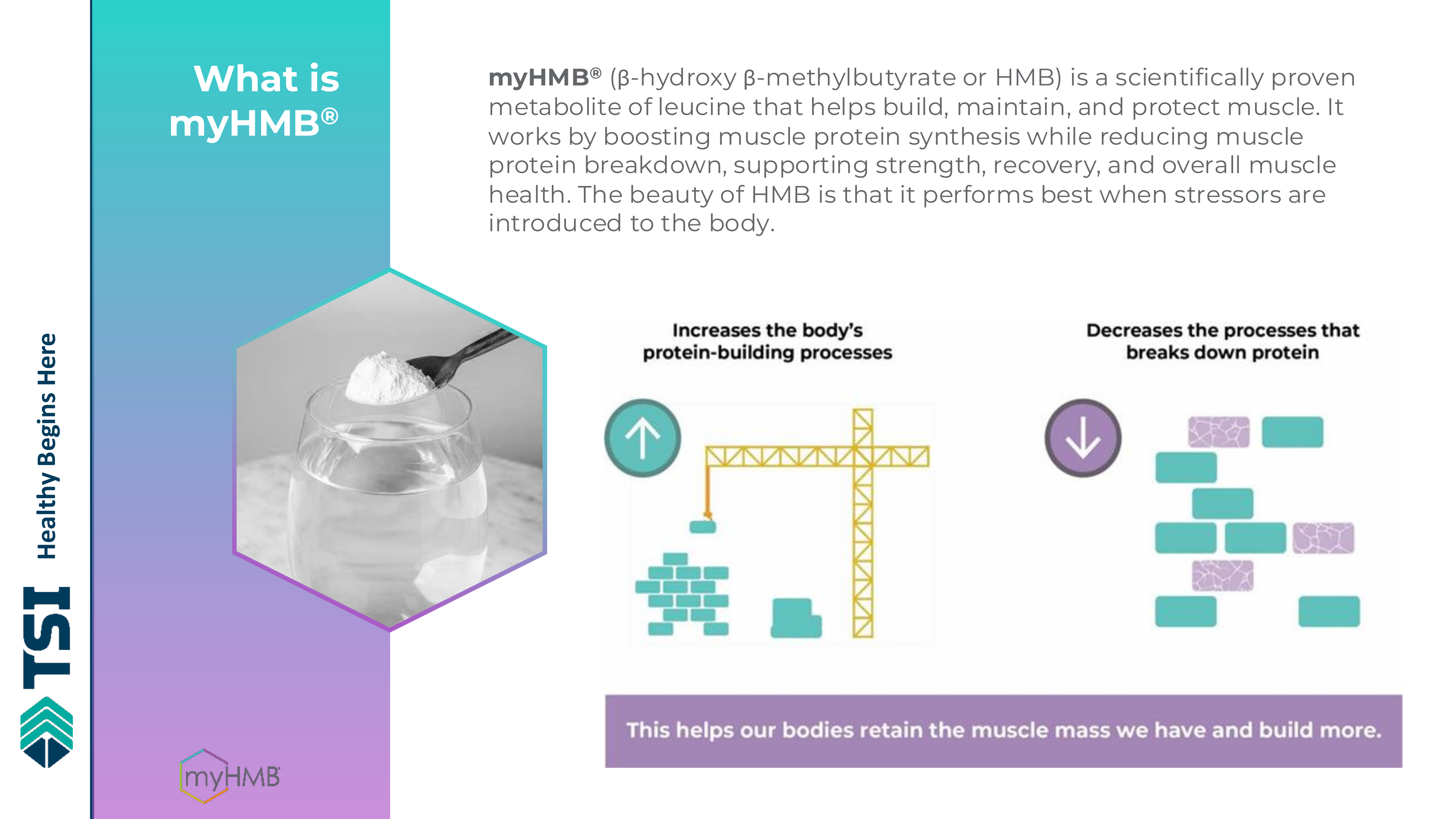
Scientific diagram illustrating HMB as leucine metabolite that increases protein-building processes (construction crane visual) while decreasing protein breakdown (falling blocks), leading to net muscle retention.
We have a comprehensive guide on HMB's mechanisms and applications in our complete guide to HMB, but below is a breakdown, especially the parts specific to women's muscle health:
The Dual-Action Mechanism
HMB works through two complementary pathways:
- Increased Protein Synthesis: HMB activates the mTOR (mammalian target of rapamycin) signaling pathway, the cellular machinery responsible for initiating muscle protein synthesis.[9] When you take HMB around training sessions, it amplifies the anabolic signal triggered by resistance exercise, enhancing your body's muscle-building response.
- Decreased Protein Breakdown: Simultaneously, HMB reduces muscle protein degradation by inhibiting the ubiquitin-proteasome pathway -- the system your body uses to break down damaged or unnecessary proteins.[9] During periods of stress (training, calorie restriction, inactivity, illness), your body accelerates muscle breakdown. HMB acts as a brake on this process, preserving hard-earned muscle tissue.
This dual action creates a more favorable net protein balance: you build more while breaking down less. The mathematical advantage compounds over weeks and months, resulting in measurable improvements in muscle mass, strength, and body composition.
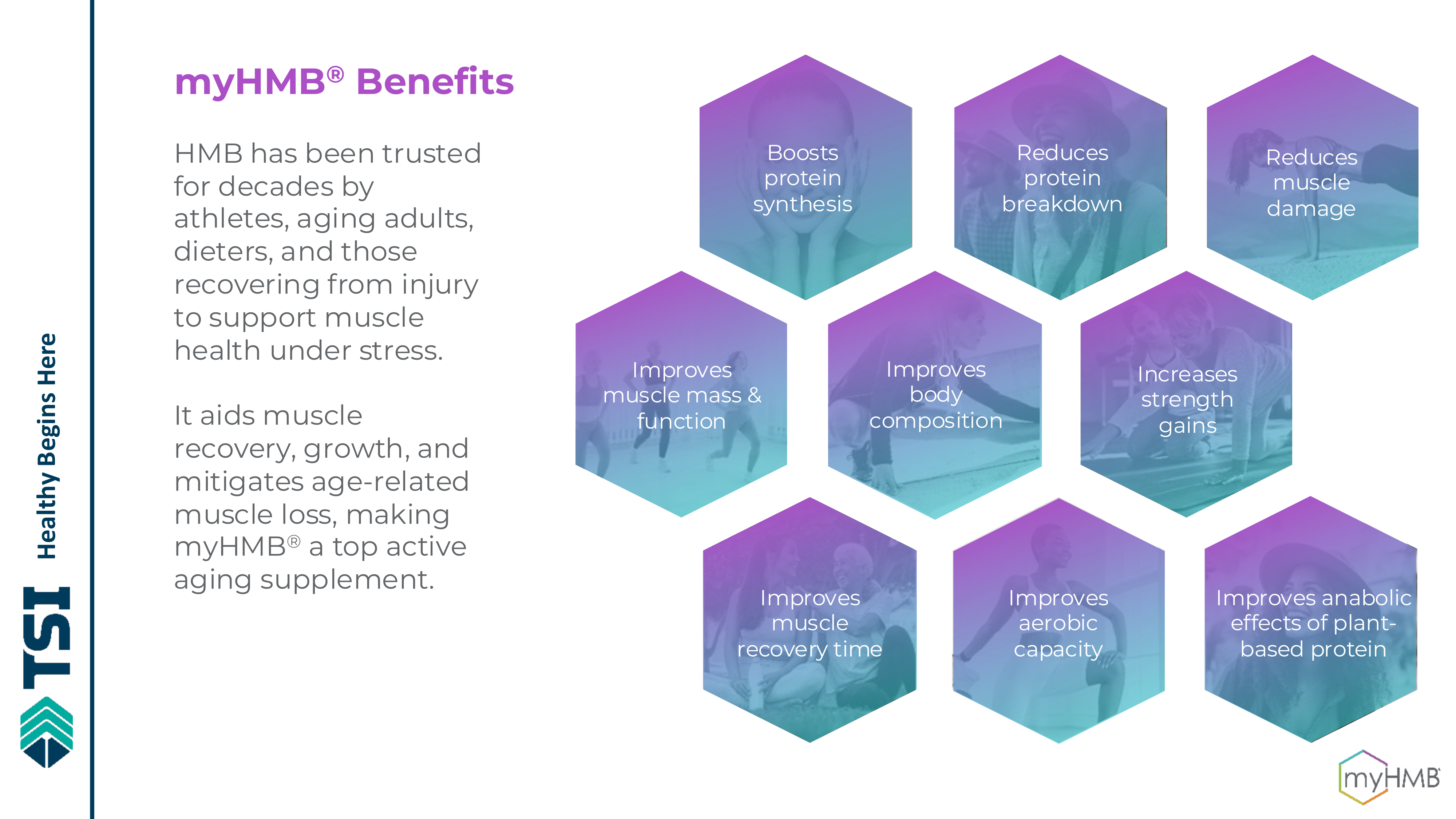
Comprehensive benefits grid showing protein synthesis boost, breakdown reduction, muscle damage decrease, mass/function improvement, body composition enhancement, strength gains, recovery time reduction, aerobic capacity improvement, and plant protein synergy.
Even better, the most commonly-used form of myHMB is calcium HMB, which provides an additional calcium source that women often seek!
With lower baseline muscle mass, less testosterone, lower-calorie diets, and common age-related muscle mass, women can use every bit of help they can get, and as the well-documented research data shows, myHMB is an extraordinarily helpful dietary supplement ingredient.
When HMB Shines Brightest
HMB performs best under stress --situations where muscle is most vulnerable to breakdown:
- Calorie restriction for fat loss
- Intense training periods with high volume or frequency
- Periods of inactivity due to injury or illness
- Aging, particularly post-menopause
- Dietary restriction that limits protein intake
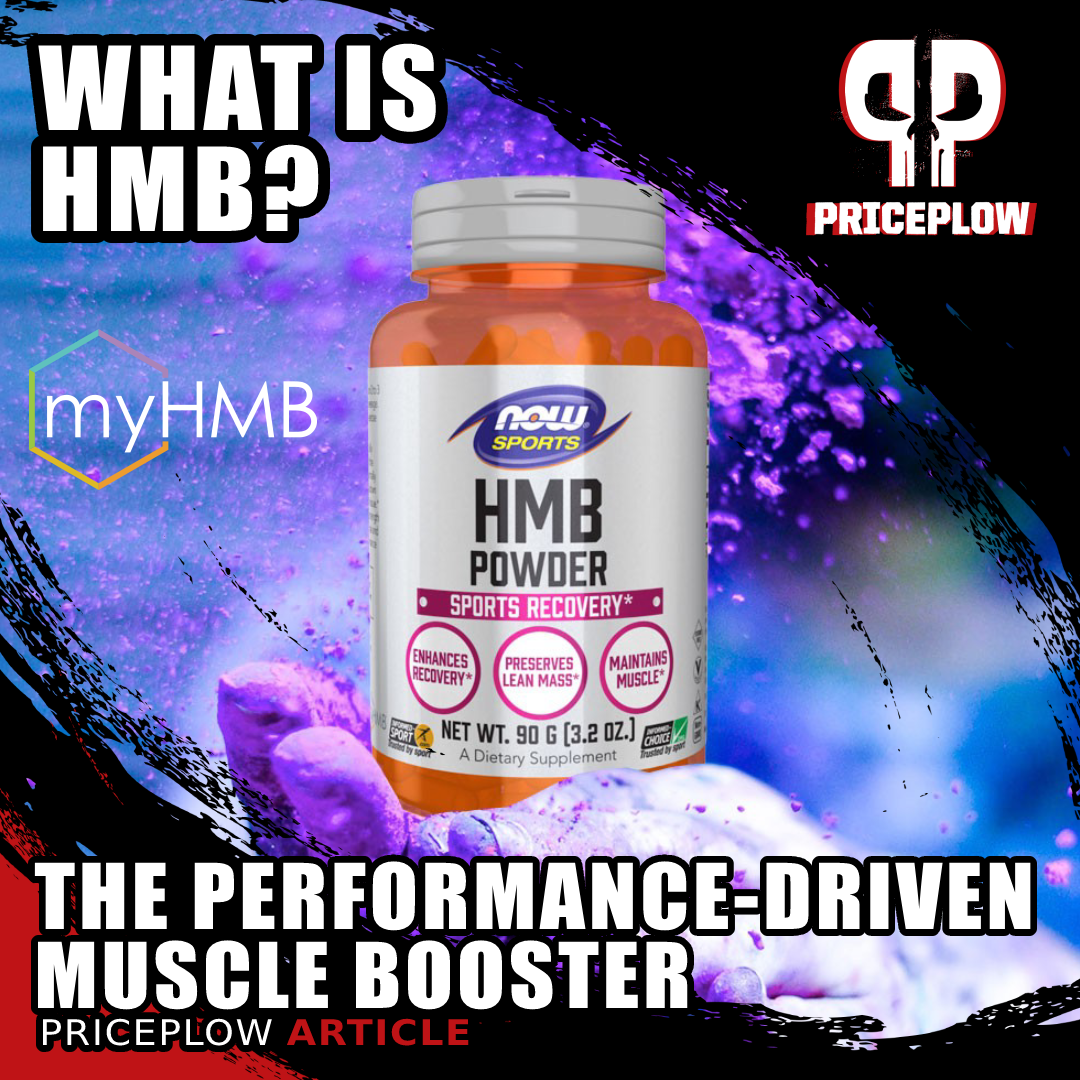
Read the full story in PricePlow's main HMB Supplements article.
During stable maintenance periods with adequate calories and protein, HMB's benefits become less dramatic, but are still valuable (especially if needing additional calcium). The ingredient excels at protecting what you've built during challenging times -- making it insurance for your muscle bank account. Additionally, most women simply don't eat as nearly as much protein as men, making the leucine metabolite that much more important.
The Bottom Line
myHMB offers women a research-backed tool for building muscle, preserving lean mass during fat loss, and maintaining strength as they age. Its dual mechanism of increasing synthesis while decreasing breakdown provides advantages that protein alone cannot deliver. For women working against lower testosterone, hormonal transitions, and smaller baseline muscle mass, myHMB levels the playing field.
The Research: HMB in Women
The scientific literature on HMB spans decades and includes hundreds of studies at this point, but historically, most human research is focused on men. While women are generally underrepresented in sports nutrition and exercise science research,[10] the good news is that TSI Group has done a fantastic job making sure that the benefits are well-documented in women.
A growing body of research demonstrates HMB's effectiveness specifically in women across different ages, training states, and goals. These studies reveal consistent benefits for body composition, strength, and muscle preservation under various conditions.
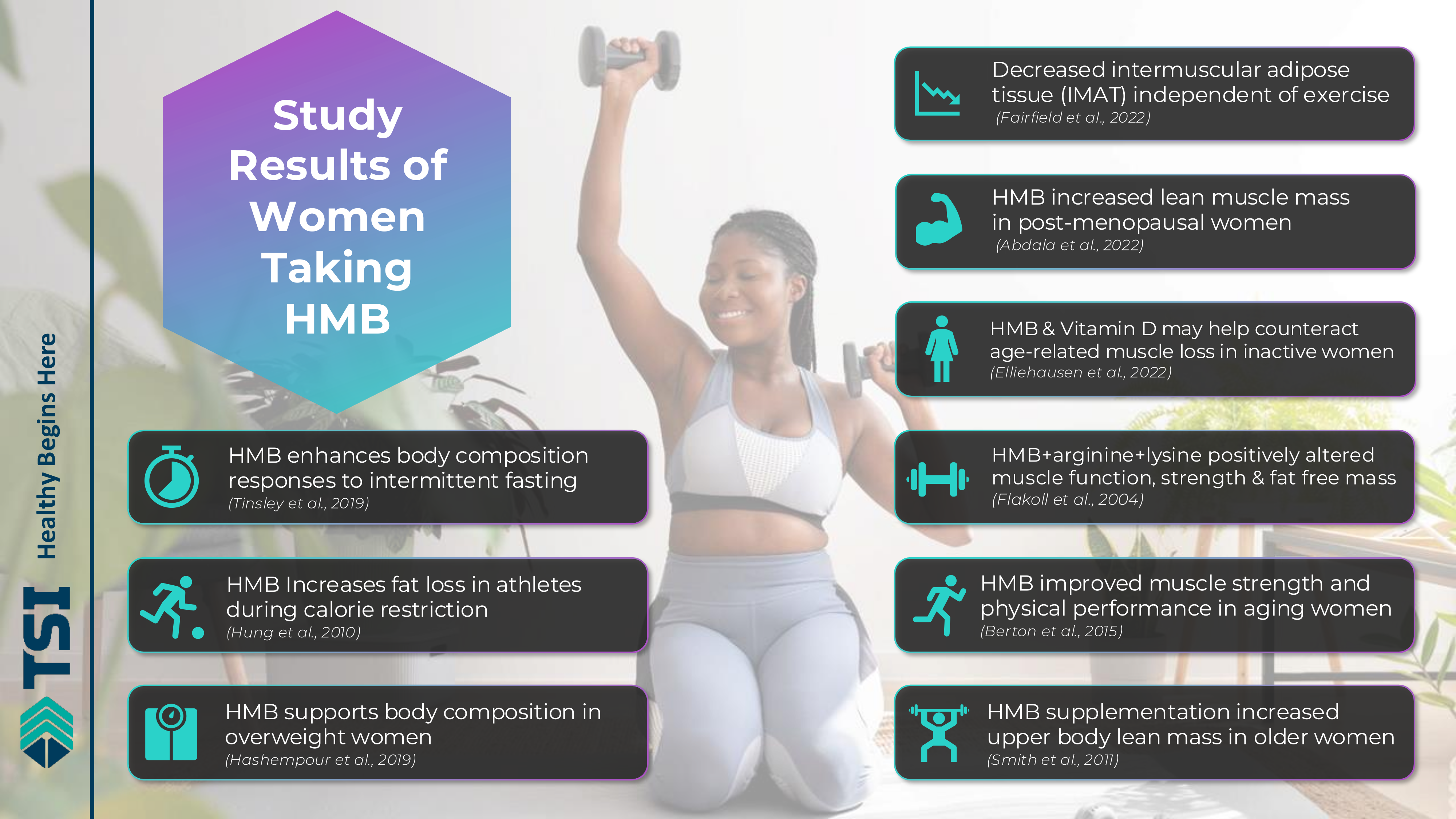
Research summary highlighting eight key study findings: intermuscular fat reduction, lean mass increases, muscle loss prevention, intermittent fasting enhancement, athlete performance, overweight women benefits, aging women improvements, and upper body mass gains.
Body Composition: Fat Loss Without Muscle Loss
The most compelling research in women centers on body composition changes -- the holy grail of reducing fat mass while preserving or increasing lean mass. Several studies demonstrate HMB's ability to shift this ratio favorably:
Time-Restricted Feeding + HMB: The Synergistic Effect
Tinsley and colleagues investigated whether HMB supplementation could enhance the effects of time-restricted feeding (TRF) in active women.[11]
Twenty-four women aged 18-30 were randomized into three groups for eight weeks:
- Control: normal eating schedule with placebo
- TRF: eating window restricted to noon-8pm with placebo
- TRF+HMB: eating window restricted to noon-8pm with 3g HMB daily
All participants completed resistance training three days per week using identical protocols.
The results revealed HMB's protective effects during energy restriction. Only the TRF+HMB group achieved statistically significant decreases in both fat mass and body fat percentage. The TRF-only group showed trends toward fat loss, but the addition of HMB pushed the results past the threshold of statistical significance, demonstrating that HMB enhanced the body composition benefits of time-restricted eating.
For women using intermittent fasting approaches, this research suggests HMB provides an edge in preserving muscle while losing fat.
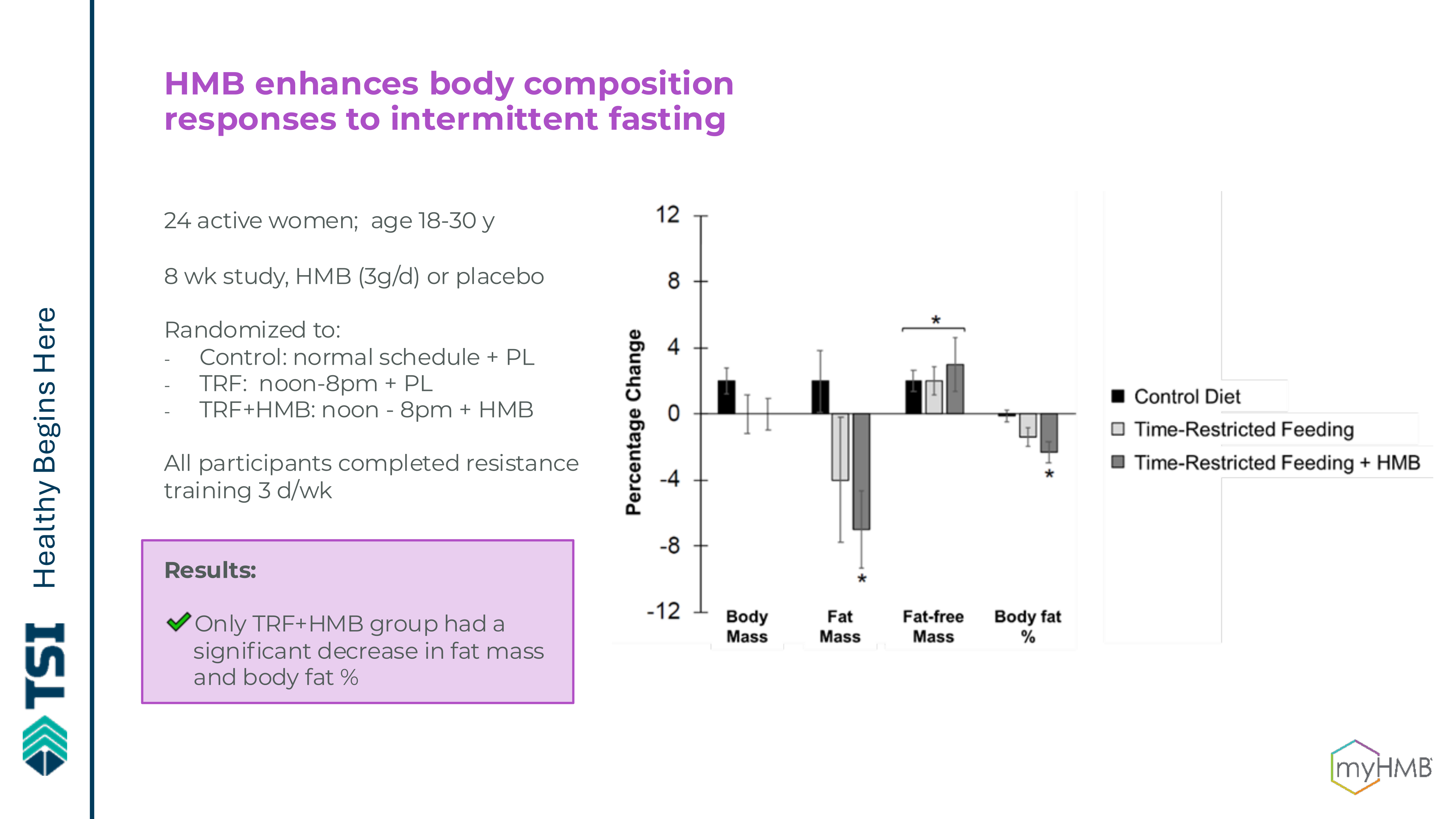
Study data from 24 women aged 18-30 showing percentage changes in body mass, fat mass, fat-free mass, and body fat percentage, with only TRF+HMB group achieving significant fat loss.
Overweight Women: Results Without Structured Exercise
Hashempour and colleagues examined HMB in a population often overlooked in sports nutrition research: sedentary, overweight women.[12]
Forty women with BMIs between 25-30 kg/m² received either 2.5g HMB daily or placebo for six weeks. All participants received nutritional counseling, but followed no structured diet or exercise program.
The HMB group experienced significant improvements across multiple measurements:[12]
- Weight: decreased
- Body fat percentage: decreased
- Fat mass: decreased
- Hip circumference: decreased
- Hip skinfold thickness: decreased
The placebo group showed no significant changes in any measurement.
These results demonstrate HMB's effects extend beyond trained athletes. Even without structured exercise protocols, HMB helped overweight women improve body composition -- likely through its dual effects on protein synthesis and breakdown combined with modest dietary improvements from nutritional counseling.
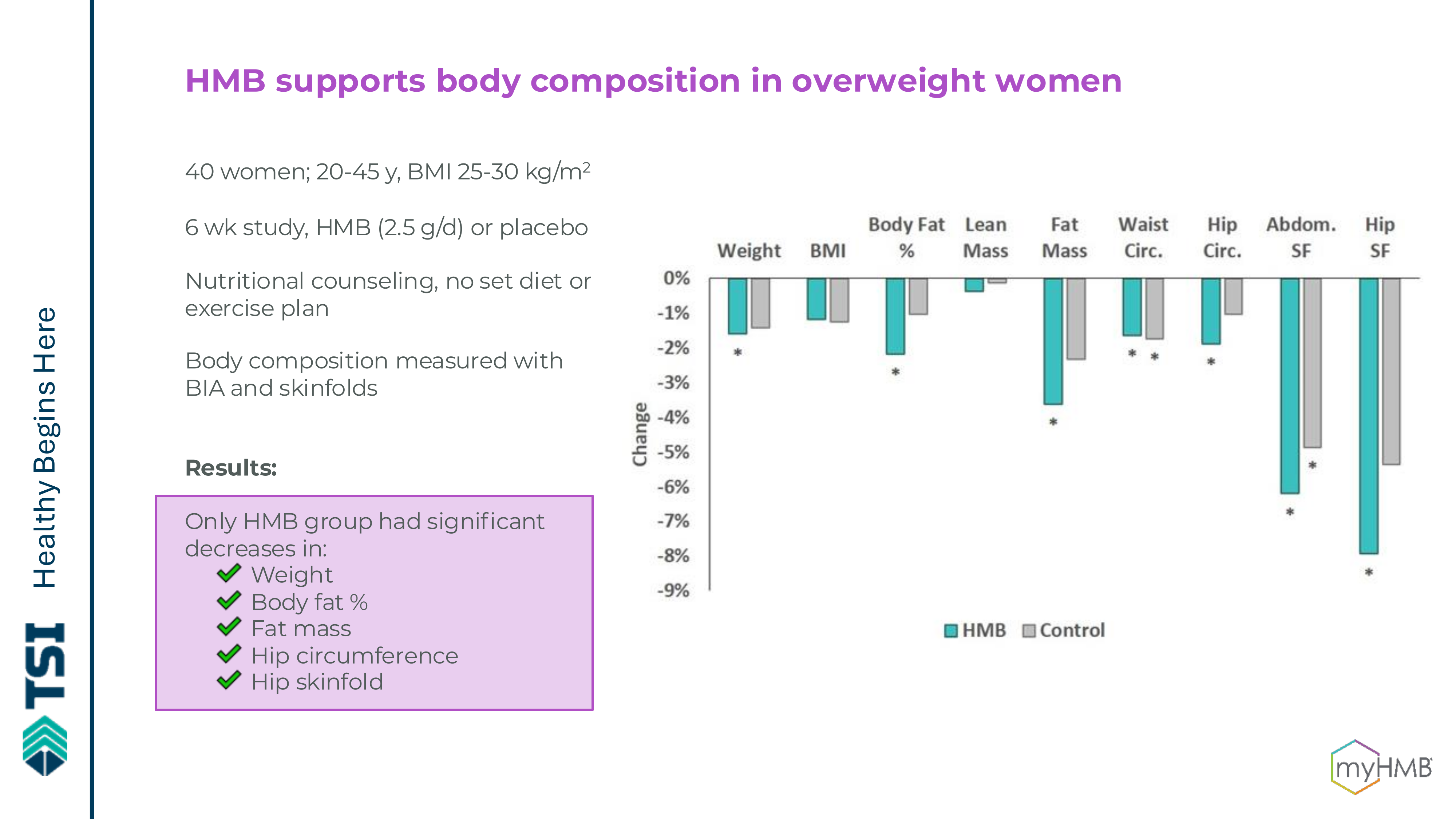
Detailed measurement chart comparing HMB vs control groups across weight, BMI, body fat percentage, lean mass, fat mass, and circumference measurements, showing significant improvements in HMB group only.
Female Athletes During Calorie Restriction: Performance Preserved
Competitive athletes frequently restrict calories to achieve specific body weights or body compositions for their sport. This practice risks muscle loss and performance decline, a trade-off that can undermine the very goals driving the restriction.
Hung and colleagues studied eight female judo athletes (average age 22) during a three-day period of calorie restriction.[13] Half received 3g HMB daily; half received placebo.
The contrast in outcomes was stark:
HMB Group:
- Body fat: -5%
- Muscle mass: -0.6% (minimal loss)
- Peak power: -5.2%
- Grip strength: +2.8%
- Shuttle run performance: -3.6%
Placebo Group:
- Body fat: no change
- Muscle mass: -1.4%
- Peak power: -10.8%
- Grip strength: -3.8%
- Shuttle run performance: -5%
The HMB group achieved their primary goal -- fat loss -- while maintaining most of their muscle mass and performance. The placebo group lost muscle without losing fat and experienced dramatic performance decrements.
For athletes cutting weight, these results demonstrate HMB's value in preserving the strength and power that determine competitive success.
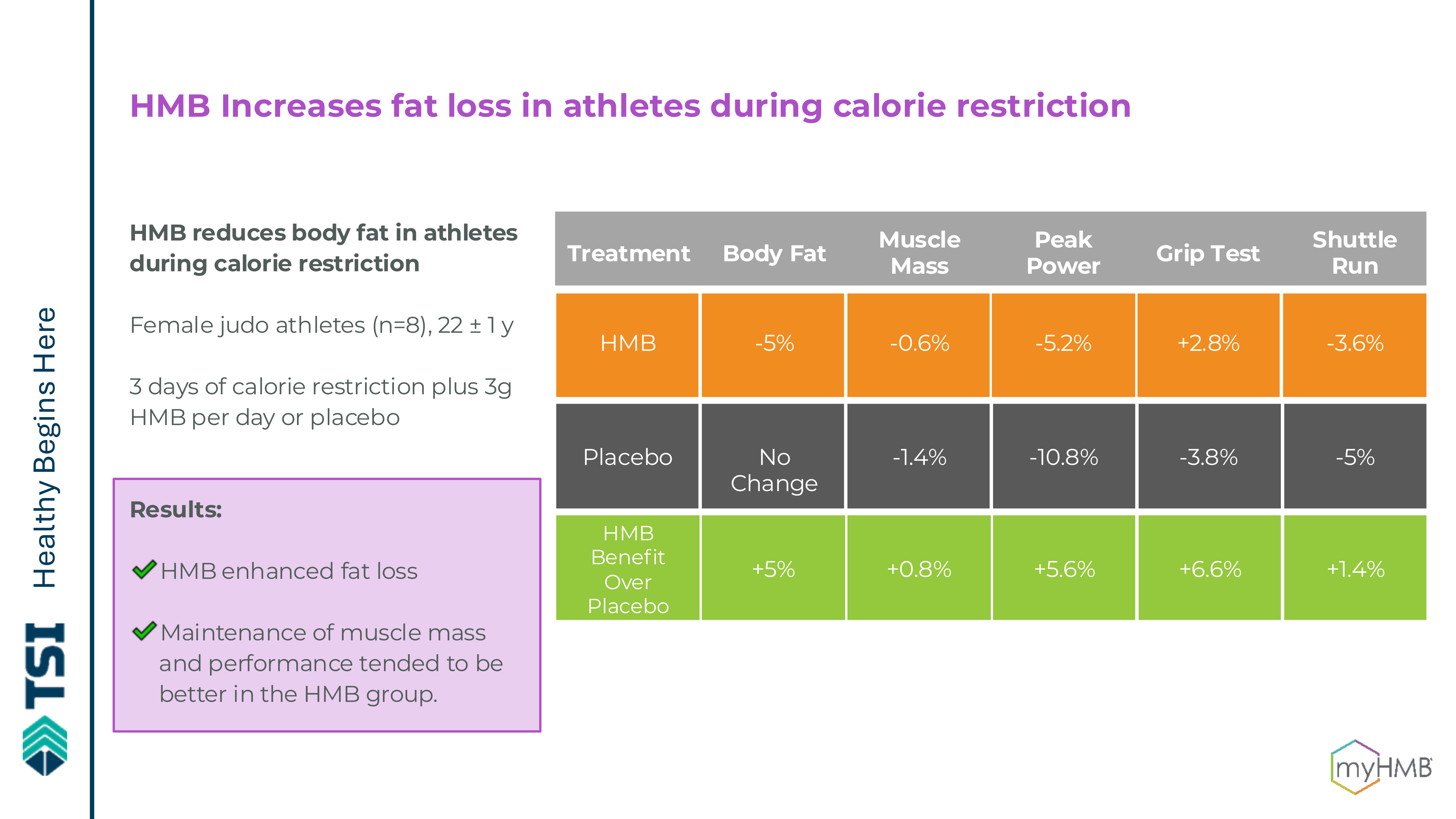
Performance comparison table showing HMB group achieved 5% fat loss with minimal muscle loss and better strength retention versus placebo group's muscle loss without fat reduction.
Aging and Postmenopausal Women: Fighting Muscle Loss
Age-related muscle loss accelerates post-menopause, creating a critical window where interventions can make substantial differences in long-term function and independence.
-
HMB + Vitamin D: Results Without Exercise
Fairfield and colleagues conducted a 12-week trial in 43 healthy middle-aged women (45-60 years old) examining the effects of HMB plus vitamin D3.[14]
Participants were randomized to receive either:
- 3g HMB + vitamin D3 daily
- Placebo
Within each supplement group, half followed a resistance exercise protocol while half remained sedentary.
The HMB + vitamin D combination produced improvements even in sedentary women:
- Intermuscular adipose tissue (IMAT): decreased in both exercising and sedentary HMB groups
- Leg muscle mass: increased in sedentary HMB subjects
Intermuscular adipose tissue (fat deposited within and between muscle fibers) increases with aging and contributes to metabolic dysfunction and reduced muscle quality. The finding that HMB + vitamin D decreased IMAT independent of exercise suggests metabolic benefits beyond what training alone provides.
Scientific graphs comparing sedentary and resistance training groups show how HMB plus vitamin D decreased harmful fat deposits within muscle tissue, even without exercise intervention.
The increase in leg muscle mass among sedentary women taking HMB + vitamin D challenges conventional wisdom. While exercise provides the optimal stimulus for muscle growth, this research demonstrates that targeted supplementation can support muscle health even in inactive populations -- potentially offering benefits for women unable or unwilling to engage in structured training.
-
Elderly Women: Functional Improvements
Flakoll and colleagues studied a combination of HMB (3g), arginine, and lysine in elderly women, examining effects on muscle function, strength, and body composition.[15]
The supplemented group showed improvements in:
- Muscle function: enhanced
- Strength: increased
- Fat-free mass: higher
These functional improvements translate to real-world benefits: easier performance of daily activities, reduced fall risk, and maintained independence.
-
Upper Body Lean Mass in Older Women
Smith and colleagues demonstrated that HMB supplementation increased upper body lean mass in older women engaged in resistance training.[16]
Strategic nutrition breakdown: protein requirements (1.2-1.6g/kg/day), myHMB's dual mechanism, creatine dosing (3-5g daily), and vitamin D recommendations (800-2000 IU).
Upper body strength matters for women, affecting the ability to carry groceries, lift objects overhead, and perform countless daily tasks. The finding that HMB specifically enhanced upper body lean mass addresses a common concern among aging women.
These findings across multiple studies in older and post-menopausal women establish HMB as a valuable tool during the life stage when muscle preservation becomes most challenging and most critical.
The Consistent Pattern
Despite differences in study design, populations, and protocols, a consistent pattern emerges from research in women:
- HMB preserves muscle during calorie restriction, enabling fat loss without the muscle loss that typically accompanies dieting.
- HMB enhances body composition changes when combined with training or dietary interventions, improving results beyond what these interventions achieve alone.
- HMB supports muscle health in aging women, helping counteract the accelerated muscle loss that follows menopause.
- HMB provides benefits across the training spectrum, from sedentary women to competitive athletes.
The research validates HMB as more than a supplement for male bodybuilders... it addresses the specific challenges women face in building and maintaining muscle throughout their lifespan.
Implementation and Stacking
The research demonstrates what's possible. Now comes the practical part: implementing HMB and supporting strategies into your routine for measurable results.
When to Start and What to Expect
Start now, regardless of age, training status, or current muscle mass. Muscle responds to stimulus at any age, and the best time to build reserves is before you need them.
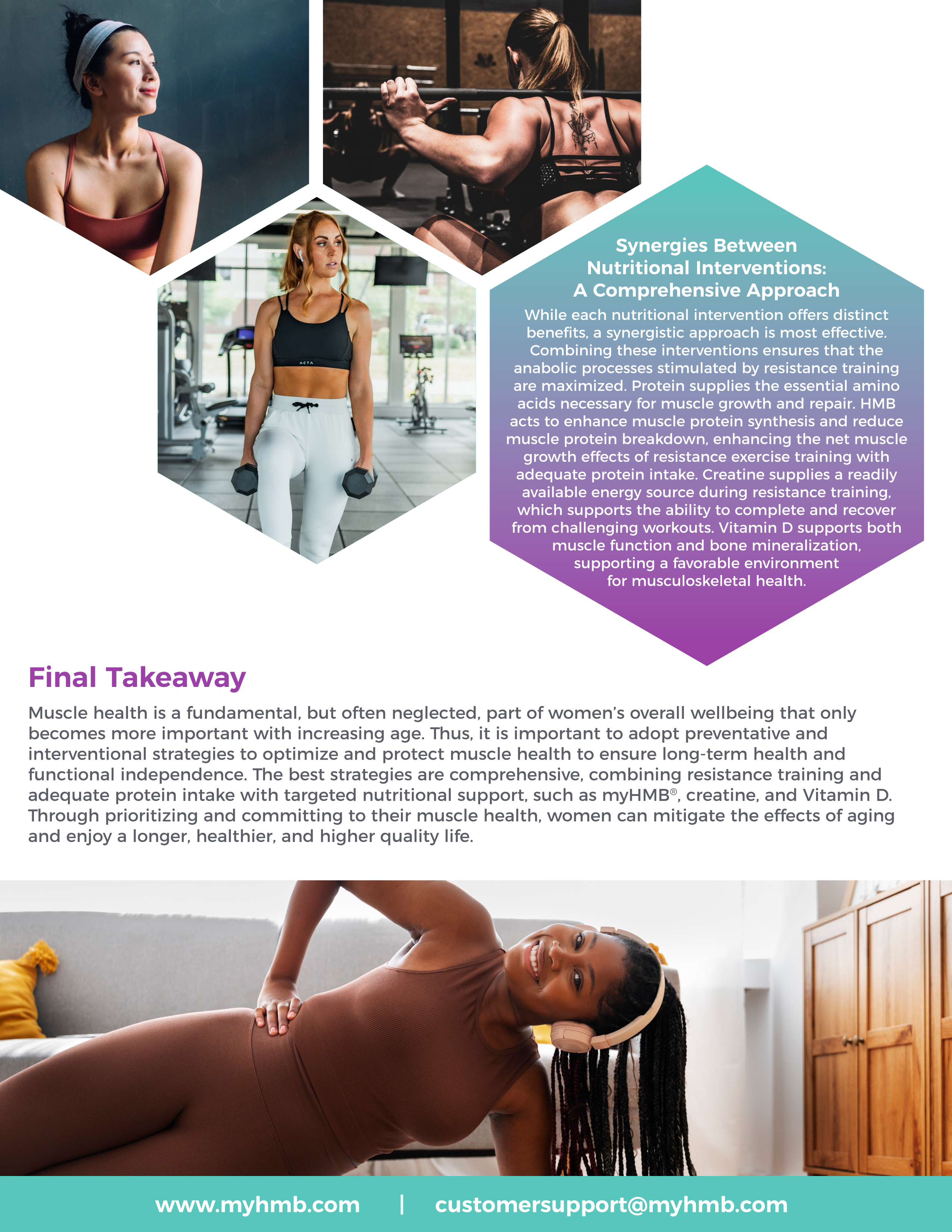
Final takeaway emphasizing combined approach of resistance training with targeted nutrition (protein, HMB, creatine, vitamin D) for comprehensive muscle health.
Timeline for results:
- Strength gains typically emerge within 2-4 weeks of consistent training and supplementation. You'll notice weights feeling lighter, reps becoming easier, and daily tasks requiring less effort.
- Body composition changes become visible around 6-8 weeks. Fat loss and muscle definition take longer to manifest than strength improvements, requiring patience and consistency.
- Long-term benefits accumulate over months and years. The most significant improvements in muscle mass, bone density, and metabolic health require sustained commitment -- but the compounding effects make every month of consistency worthwhile.
Track progress intelligently: strength benchmarks matter more than scale weight. A woman who maintains her weight while increasing her squat, deadlift, and pressing strength has likely lost fat and gained muscle, making for a massive win that the scale wouldn't reveal. Track weights lifted, reps completed, and how your clothes fit rather than obsessing over body weight fluctuations.
Common mistakes to avoid:
- Underestimating protein needs (especially during fat loss) or overestimating protein consumption (weigh your food and use an app to track macros)
- Inconsistent supplementation (HMB requires daily use, not just training days)
- Avoiding progressive overload (lifting the same weights indefinitely yields diminishing returns)
- Excessive cardio at the expense of resistance training
- Impatience (expecting transformation in weeks rather than months)
The Complete Stack: Four Pillars of Muscle Support
No single supplement builds muscle alone. Optimal results require a strategic combination of nutrients working synergistically.
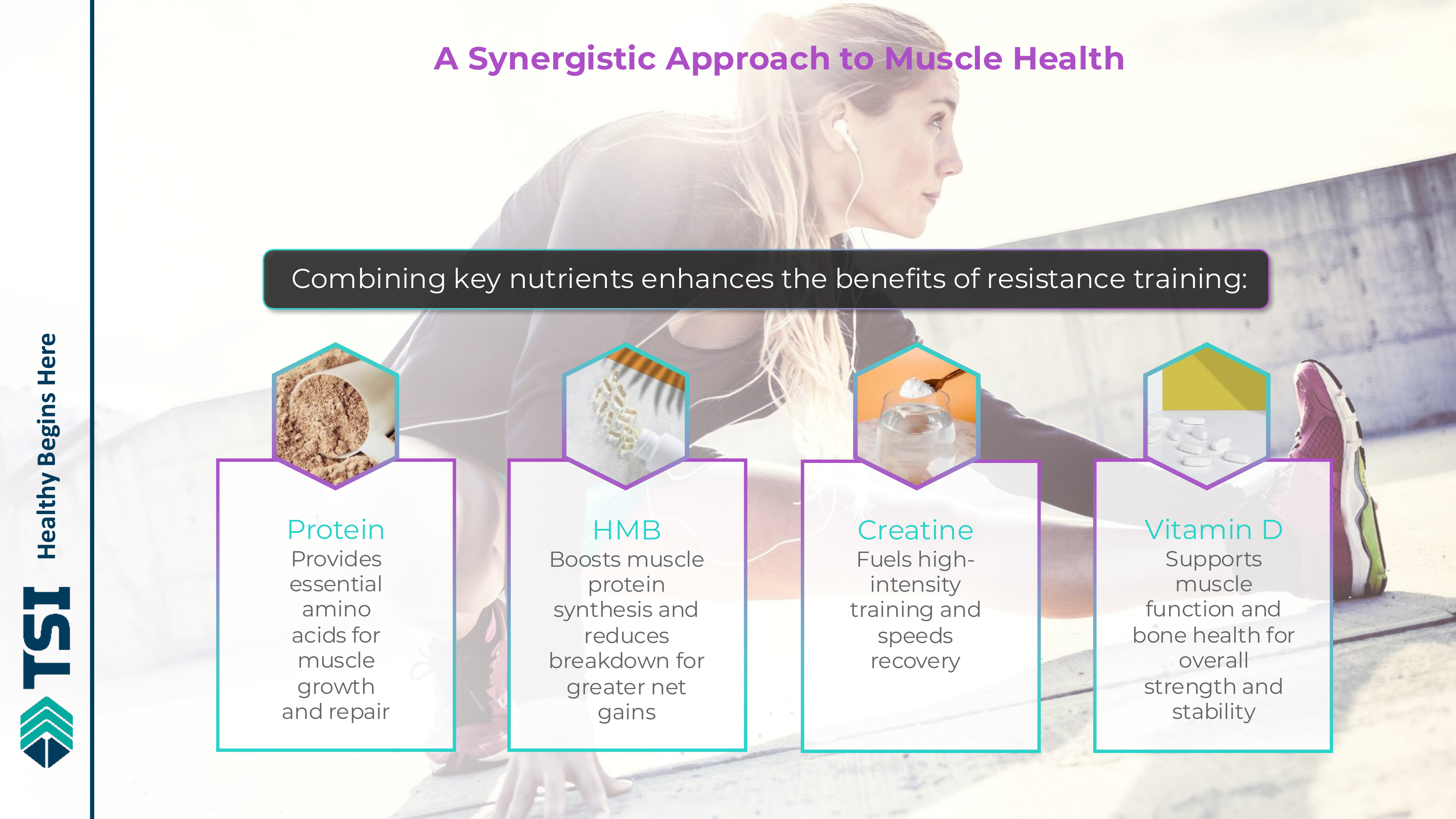
Synergistic approach diagram showing how protein provides amino acids for growth, HMB boosts synthesis while reducing breakdown, creatine fuels training and recovery, and vitamin D supports muscle and bone function.
-
Protein: The Foundation
The recommended daily allowance of 0.8g per kilogram body weight meets the minimum requirements to prevent deficiency... but "preventing deficiency" differs dramatically from "optimizing muscle health".[17]
Target intake: 1.2-1.6g per kilogram body weight daily, scaled toward the higher end for:
Nutritional guide showing RDA of 0.8g/kg/day versus expert recommendations of 1.2-1.6g/kg/day, with special considerations for postmenopausal women and timing strategies.
- Women engaged in regular resistance training
- Those in calorie deficits for fat loss
- Postmenopausal women (who exhibit anabolic resistance requiring more protein to stimulate muscle synthesis)
Timing considerations: consuming protein within a few hours after resistance training maximizes muscle protein synthesis. While the "anabolic window" isn't as narrow as once believed, post-workout protein intake remains beneficial.
For a 150-pound (68kg) woman, this translates to roughly 82-109 grams of protein daily -- easily achievable through whole foods, but often requiring conscious planning given typical dietary patterns.
-
HMB: The Amplifier
Standard dose: 3 grams daily, taken either as a single dose or split across meals. Research demonstrates efficacy with both approaches.
Timing: HMB shows benefits when taken around training sessions or with meals. Unlike some supplements requiring precise timing, HMB works primarily through maintaining elevated blood levels throughout the day.
When HMB matters most:
- Calorie restriction or fat loss phases (preserves muscle during energy deficit)
- Periods of reduced activity due to injury or illness
- Post-menopause (combats accelerated muscle loss)
- High-volume training blocks (reduces muscle damage and accelerates recovery)
HMB functions as insurance: protecting muscle during the times it's most vulnerable to breakdown.
-
Creatine: The Performance Enhancer
Creatine deserves its status as one of the most researched and effective supplements available. For women, the benefits extend beyond strength and power to include improvements in muscle mass and function, especially post-menopause.[18]
Supplement overview detailing creatine's role in energy production, fatigue reduction, performance improvements in pre/postmenopausal women, and recommended 3-5g daily dosing.
Dosing: 2-3 grams daily maintains saturated muscle creatine stores. A 5-day loading phase at 10 grams daily (split into 4 doses) accelerates saturation but isn't necessary... daily supplementation achieves the same endpoint within 3-4 weeks.
Synergy with HMB: creatine provides readily available energy for high-intensity training, enabling you to complete more reps and lift heavier weights. HMB protects the muscle you build from that training. Research demonstrates additive effects when the two are combined.[19-21] Together, they address different limiting factors in muscle development.
-
Vitamin D: The Foundation Support
Vitamin D's role extends well beyond bone health to include muscle function, strength, and overall physical performance.[22] Many postmenopausal women exhibit deficiency or insufficiency, especially in regions with limited sun exposure.
Health information linking vitamin D to muscle function, highlighting deficiency prevalence in postmenopausal women and recommended 800-2000 IU/day supplementation for strength and stability.
Dosing: 800-2000 IU daily helps achieve and maintain optimal vitamin D levels (typically defined as blood levels above 30 ng/mL, though some experts recommend higher targets). We advise caution in overdoing the vitamin D3, however, due to calcification concerns (it's also helpful to supplement vitamin K and magnesium alongside it).
Synergy with HMB: research specifically examining HMB plus vitamin D in middle-aged women demonstrated decreased intermuscular fat and increased leg muscle mass—even in sedentary subjects.[14] The combination appears particularly effective for aging women. Long-term supplementation with calcium HMB and vitamin D3 improved muscular function in older adults, with effects enhanced by resistance training.[23]
Vitamin D status affects muscle contractile properties and strength, correcting deficiency should be considered foundational.[24]
Resistance Training: The Non-Negotiable Foundation
Supplements amplify results from training... they don't replace it. Without the stimulus of progressive resistance exercise, HMB has little to work with.
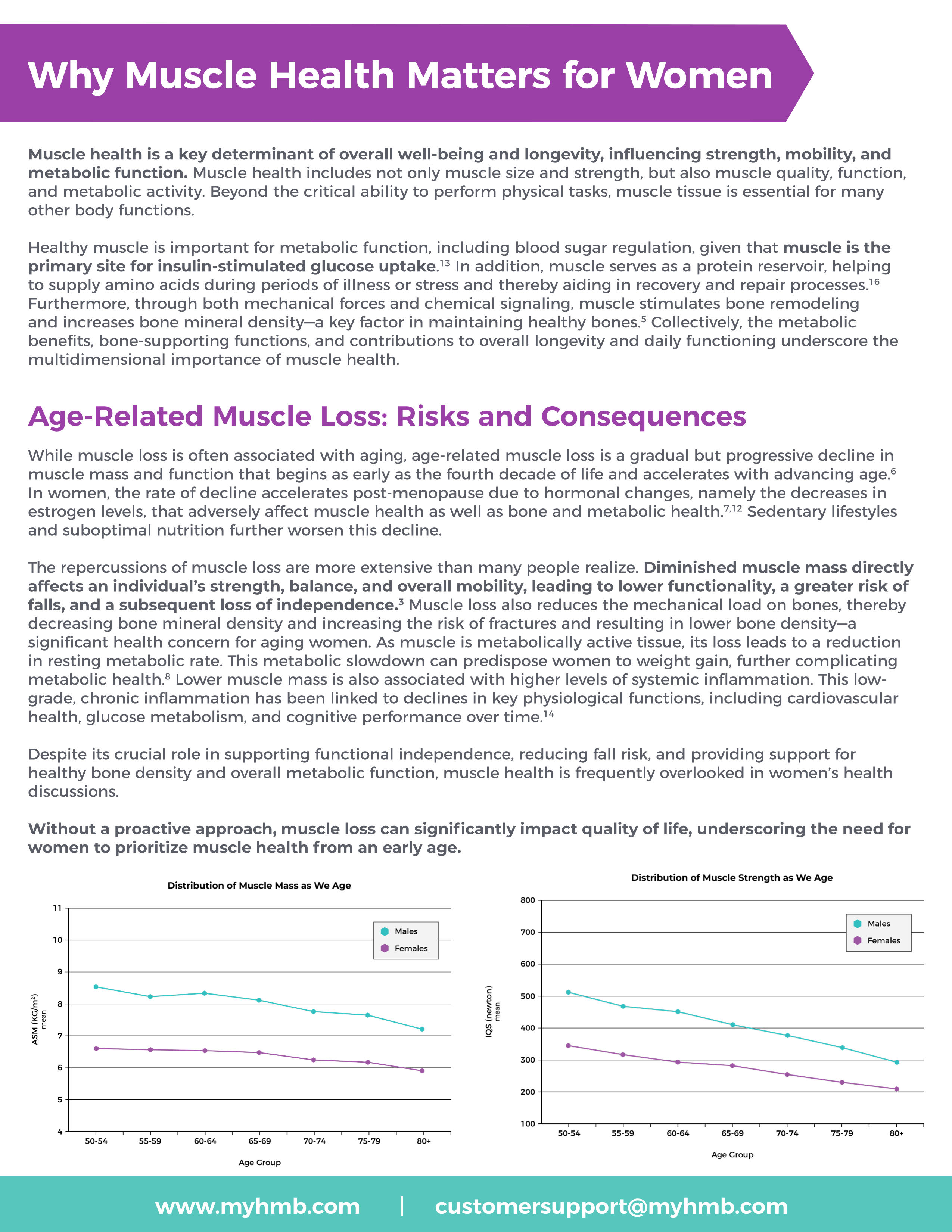
Muscle health overview with graphs showing women's lower muscle mass and strength across age groups 50-80+, demonstrating similar decline rates to men but from a lower baseline.
- Minimum effective dose: US guidelines recommend muscle-strengthening activities targeting all major muscle groups at moderate or greater intensity at least twice weekly.[25] More frequent sessions (3-4x weekly) produce better results for most women.
- Progressive overload: the key to continued adaptation. Each session should challenge muscles beyond what they've adapted to, through heavier weights, more reps, additional sets, or reduced rest periods. Lifting the same weights for the same reps indefinitely yields maintenance, not growth.
- Compound movements: prioritize exercises that work multiple muscle groups, including squats, deadlifts, presses, rows, and pull-ups (or assisted variations). These movements provide the greatest stimulus for muscle growth and functional strength.
Addressing common barriers:
- Time constraints: effective sessions require only 30-40 minutes when focused on compound movements with minimal rest. Three focused sessions weekly beats seven unfocused hours.
- Confidence and knowledge gaps: start with bodyweight movements, resistance bands, or machines that guide movement patterns. Consider working with a qualified trainer for initial technique instruction. The investment in proper form pays dividends in safety and results.
- Injury fear: proper form and gradual progression minimize risk. Start with manageable weights, focus on controlled movement, and progress conservatively. Resistance training, when done correctly, strengthens connective tissues and reduces injury risk in daily life.
HMB's role in training: by reducing muscle damage and preserving muscle during recovery, HMB allows you to train more effectively and consistently. You're less sore, recover faster, and maintain muscle mass even during challenging training blocks or life stress that might otherwise cause regression.
The synergy between training and supplementation creates results neither achieves alone. Train consistently, fuel adequately, supplement strategically, and repeat for months and years. The compounding effects build the muscle reserves that support health, function, and independence throughout your lifespan.
Products to Try and Additional Resources
HMB supplements are widely available in standalone formulations and multi-ingredient products designed for muscle building, recovery, and body composition. For women seeking HMB supplementation, several options deliver the research-supported 3-gram daily dose.
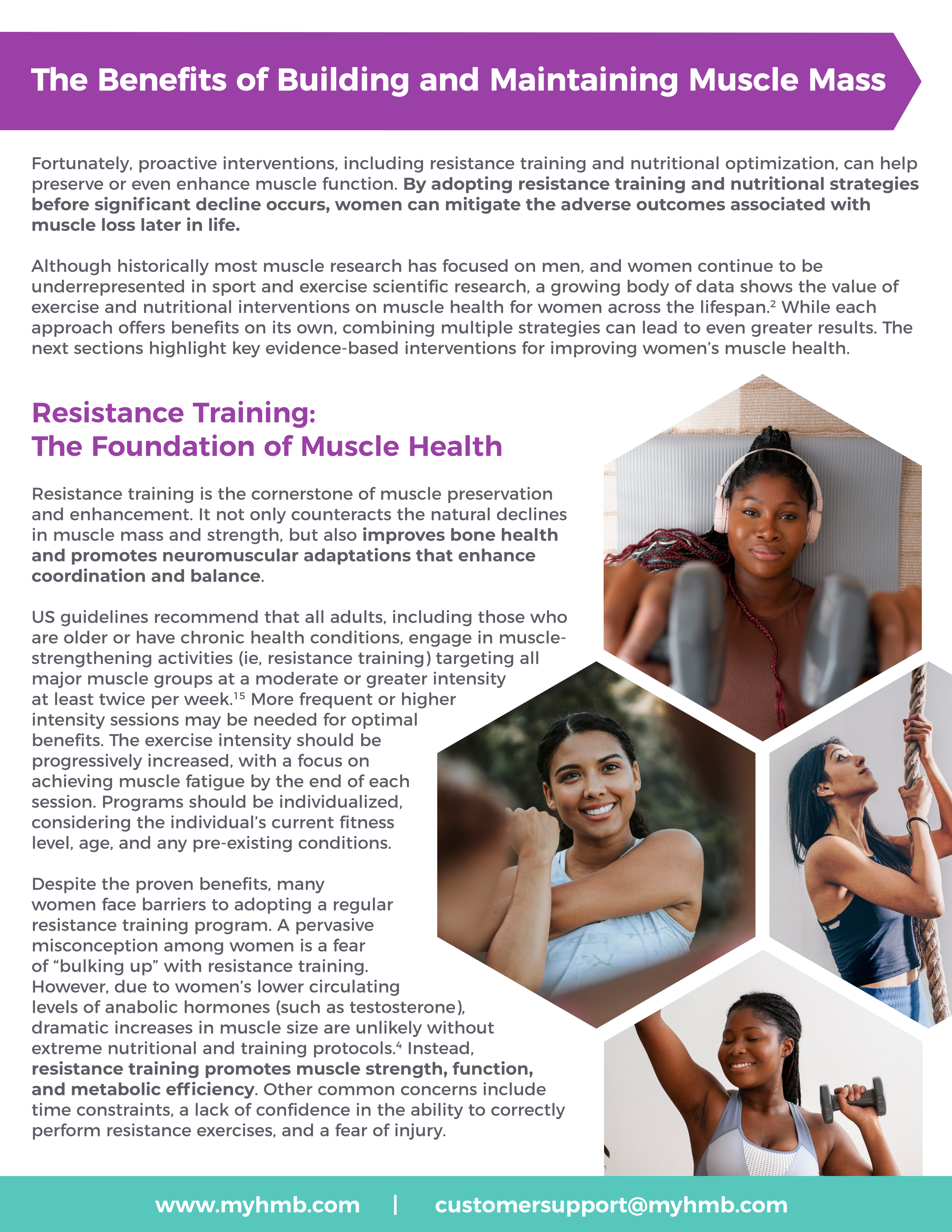
Guide covering twice-weekly resistance training guidelines, addressing "bulking up" myths, and explaining how women's lower anabolic hormones prevent dramatic muscle increases.
Where to Find HMB Products
The official myHMB website maintains a comprehensive directory of products containing their patented and trademarked ingredient at myhmb.com/where-to-buy. This resource includes standalone HMB supplements and combination formulas available through major retailers and online stores.
Featured Combination Formulas on the PricePlow Blog
Several products combine myHMB with complementary ingredients discussed in this article:
- Undefined Nutrition STRUCTURE: Brian Shaw's muscle-building formula combines myHMB with Peak ATP and creatine, addressing both energy availability during training and muscle preservation afterward. The inclusion of ATP further supports high-intensity performance alongside HMB's anti-catabolic effects.
- Advanced Muscle Plus from ABN: This formula features myHMB alongside a novel dileucine peptide, targeting muscle building through multiple leucine-related pathways.
- Animal Creatine HMB+: From the legendary Animal brand, this straightforward combination delivers creatine and myHMB together: the two supplements with the strongest evidence for muscle building and preservation.
Learn More About HMB
For readers wanting deeper dives into HMB's mechanisms, research, and applications:
- The Complete Guide to HMB Supplementation: Our comprehensive article covers HMB's history, biochemistry, research across different populations, dosing protocols, and forms (calcium salt vs. free acid).
- Episode #093 with Shawn Baier: TSI Group's Director of Science and Innovation discusses the science behind HMB, recent research developments, and practical applications. Baier has been involved in HMB research for decades and provides insider perspectives on the ingredient's evolution.
These resources complement the women-specific focus of this article with broader context about HMB's mechanisms and uses across different populations and goals.
Invest in Your Muscle Bank Account
Muscle mass functions as biological currency -- a form of wealth that pays dividends in strength, metabolic health, bone density, and functional independence throughout your lifespan. Like financial investments, muscle reserves grow through consistent deposits and compound over time. Unlike money, you can't borrow muscle when you need it.
The mathematics of muscle favor early investment. A woman who begins resistance training and strategic nutrition in her 30s or 40s builds reserves before accelerated loss begins. She enters menopause with more muscle mass, providing a buffer against the hormonally-driven decline that follows. By the time age-related challenges intensify in her 60s and 70s, she maintains the strength and function that enable independence.
Starting later still provides benefits (muscle responds to stimulus at any age) but the woman who waits until loss becomes obvious fights a harder battle. She must simultaneously reverse years of decline while combating the accelerated breakdown of aging. Both approaches work, but one requires more effort and yields smaller margins.
HMB functions as insurance for your muscle investments. During periods of stress, including calorie restriction, intense training, injury-related inactivity, illness, and hormonal transitions, muscle becomes vulnerable to breakdown. HMB's dual mechanism of increasing synthesis while decreasing degradation protects what you've built during these challenging times.
The research in women demonstrates HMB's effectiveness across the spectrum: young athletes maintaining performance during weight cuts, sedentary overweight women improving body composition without structured exercise, middle-aged women preserving muscle through menopause, and elderly women maintaining strength and function. The common thread? HMB helps women build and preserve muscle despite the unique challenges they face.
Your action plan:
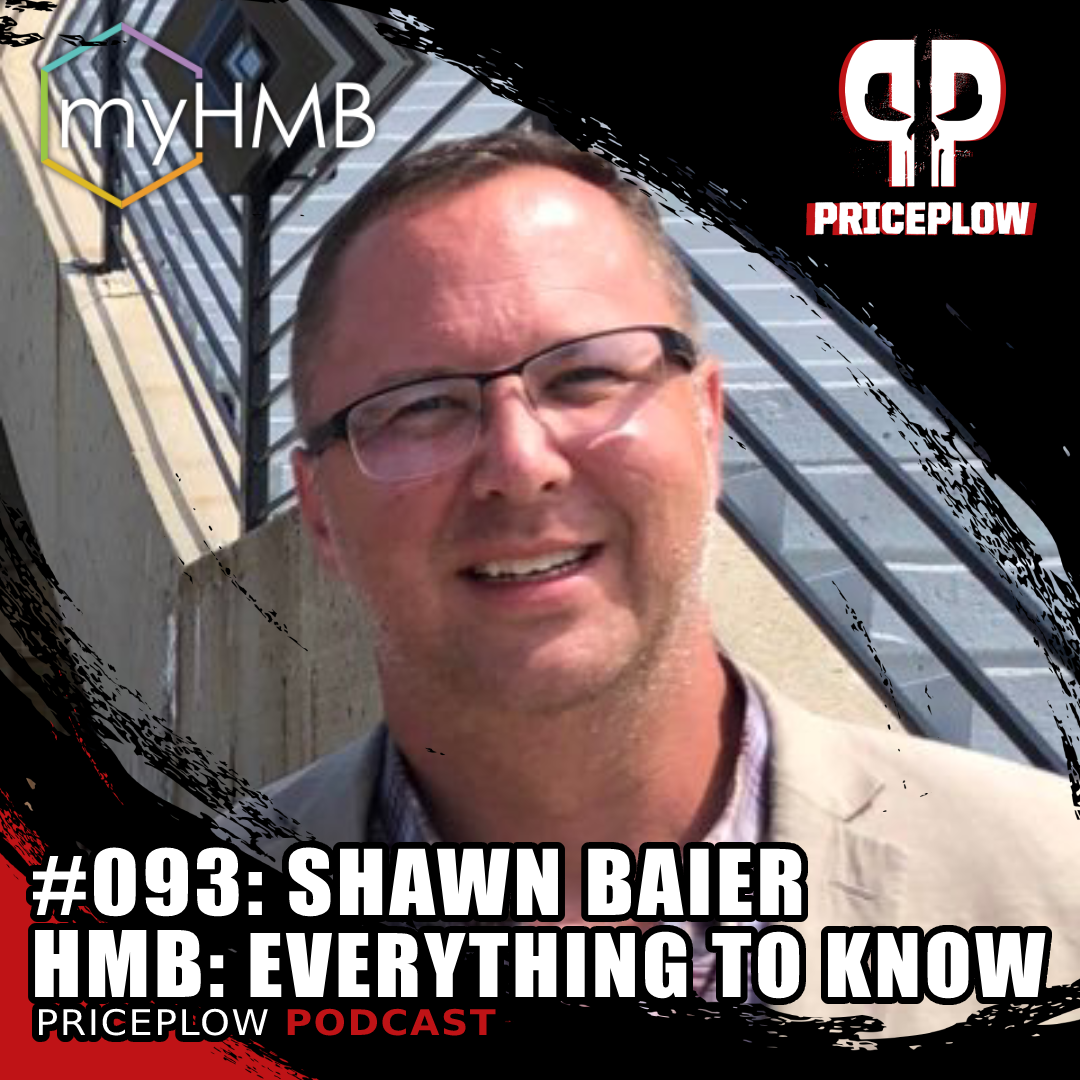
Shawn Baier joins PricePlow Podcast Episode #093 to talk HMB.
- Start resistance training if you haven't already. Twice weekly minimum, three to four times weekly for optimal results. Focus on compound movements with progressive overload. Consistency matters more than perfection.
- Optimize protein intake to 1.2-1.6 grams per kilogram body weight daily. Postmenopausal women should target the higher end. Distribute intake across meals, with emphasis on post-training consumption.
- Add myHMB supplementation at 3 grams daily. Take it consistently, not just on training days. Consider it most essential during fat loss phases, intense training periods, post-menopause, or any time muscle faces increased breakdown stress.
- Consider the complete stack: HMB works synergistically with creatine for performance and muscle building, with vitamin D for aging women, and with adequate protein as the foundation for all muscle-related adaptations.
- Track progress intelligently: strength gains, how clothes fit, energy levels, and physical function matter more than scale weight. A woman who maintains her weight while increasing her deadlift by 50 pounds has transformed her body composition and health trajectory.
- Think long-term: building meaningful muscle reserves requires months and years, not weeks. The cumulative effects of consistent training and strategic supplementation compound dramatically over time.
Muscle loss isn't inevitable -- it's a consequence of inactivity and inadequate nutrition. The women who maintain strength, function, and independence into their 70s, 80s, and beyond didn't just get lucky with genetics. They invested in their muscle bank accounts early and protected those investments during periods of stress.
Start building your reserves now. Your future self will thank you.

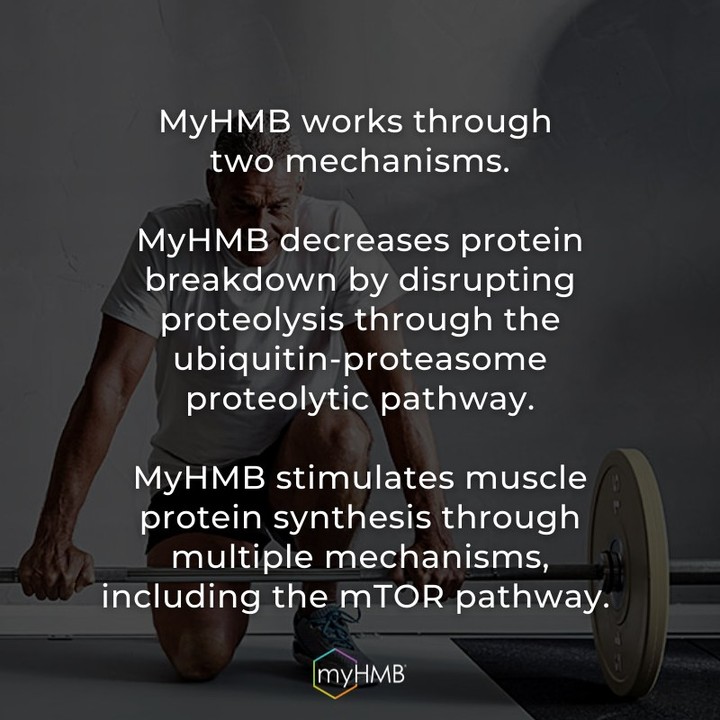
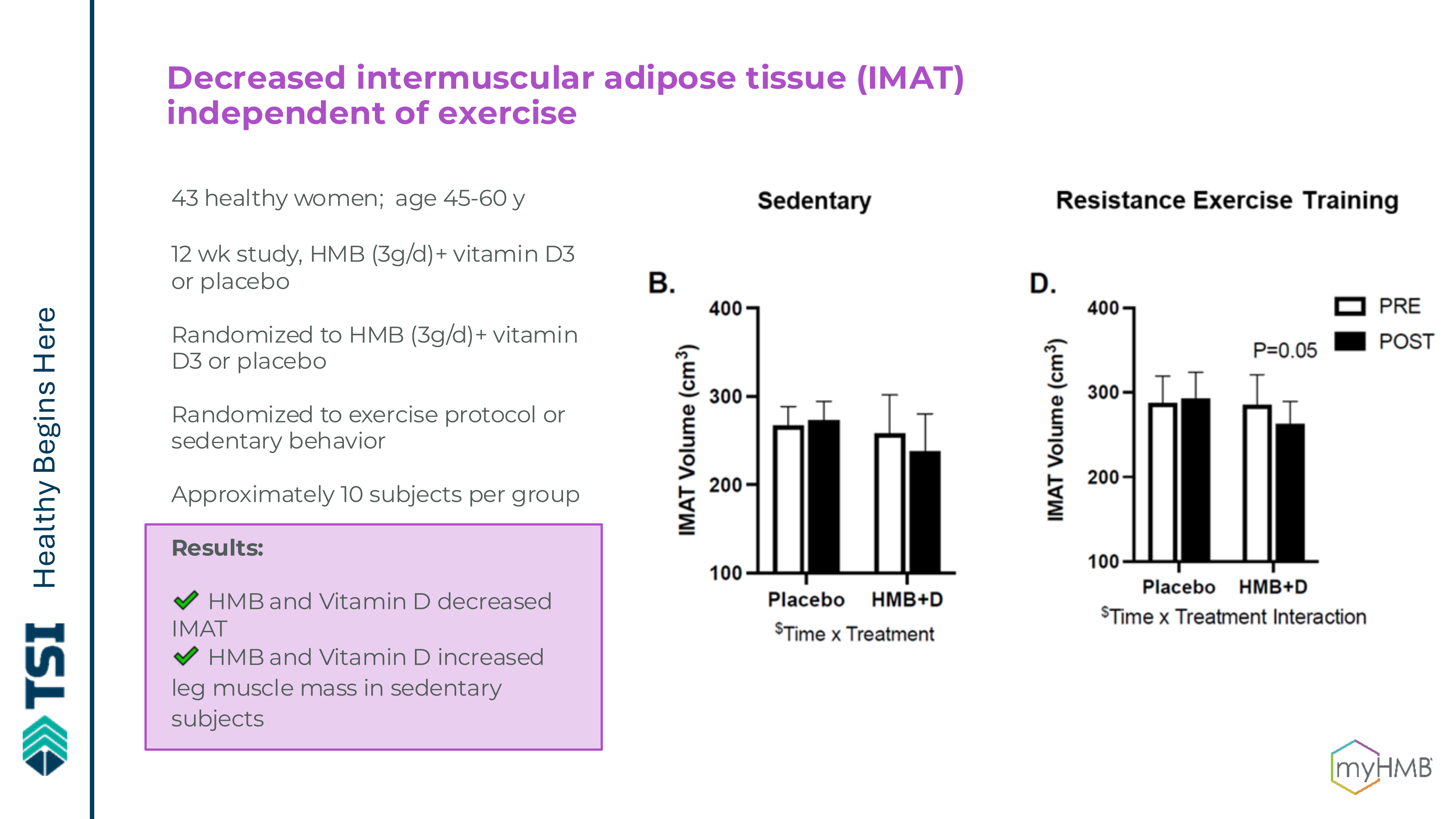
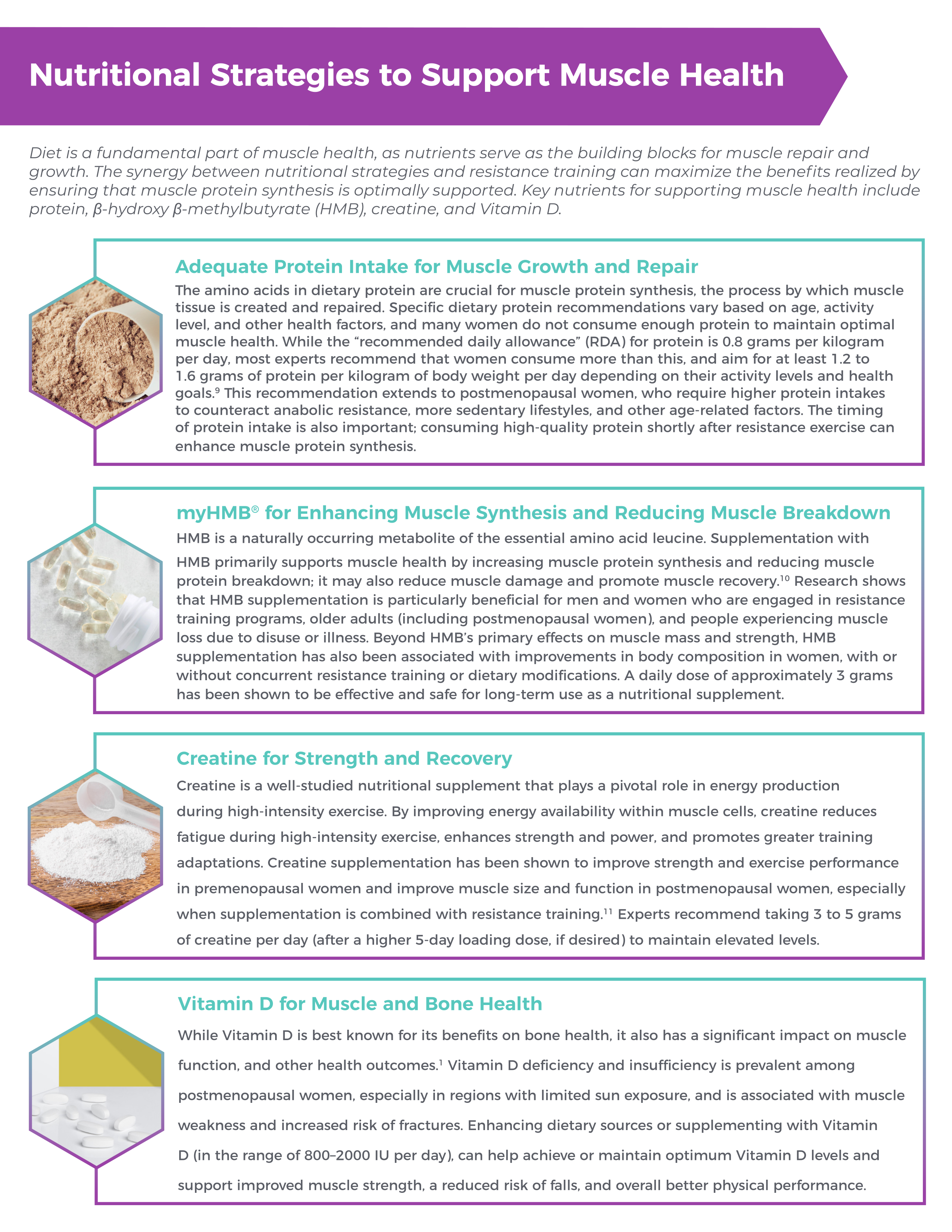
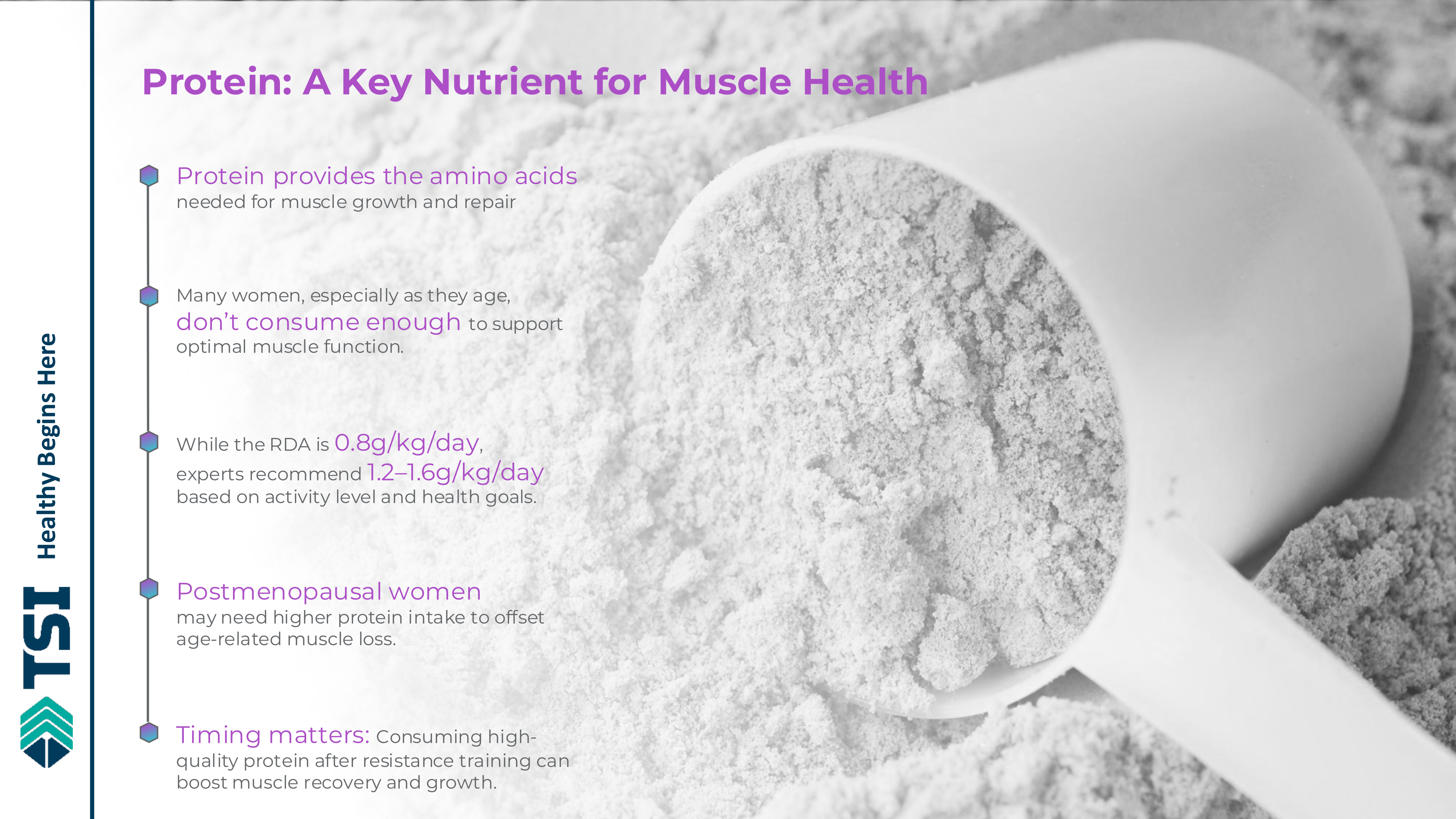
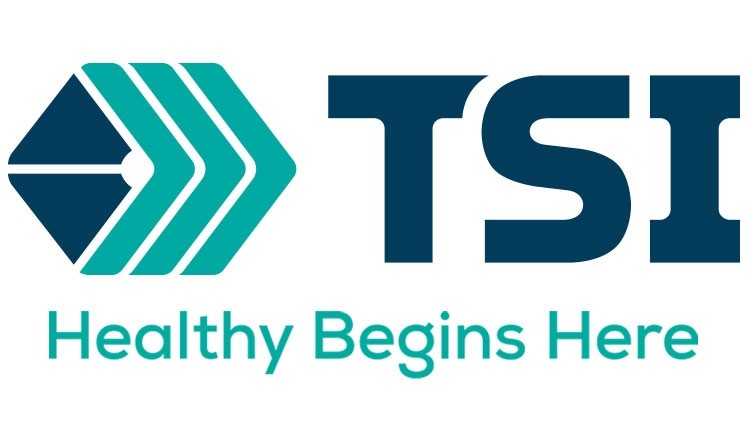
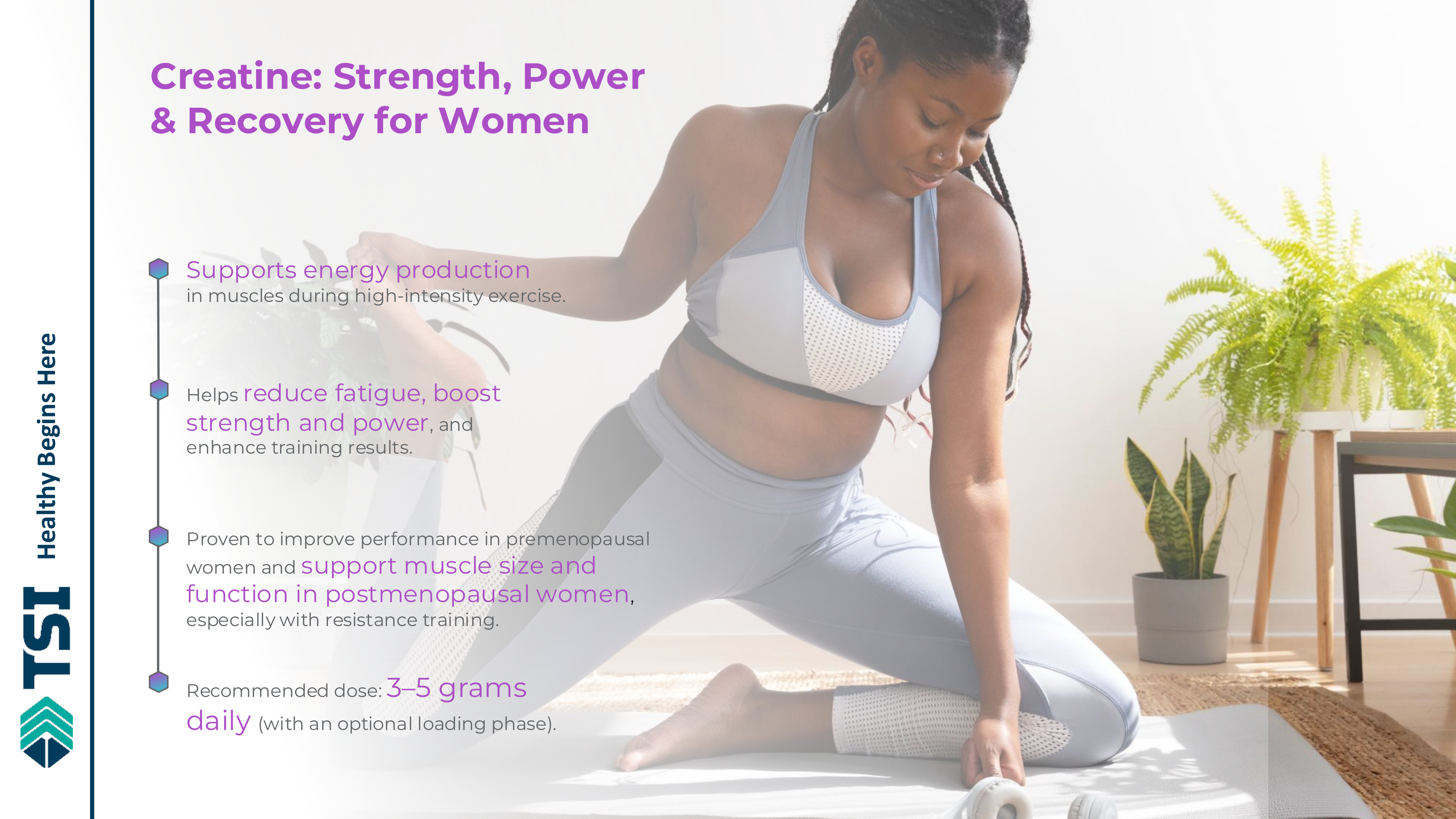
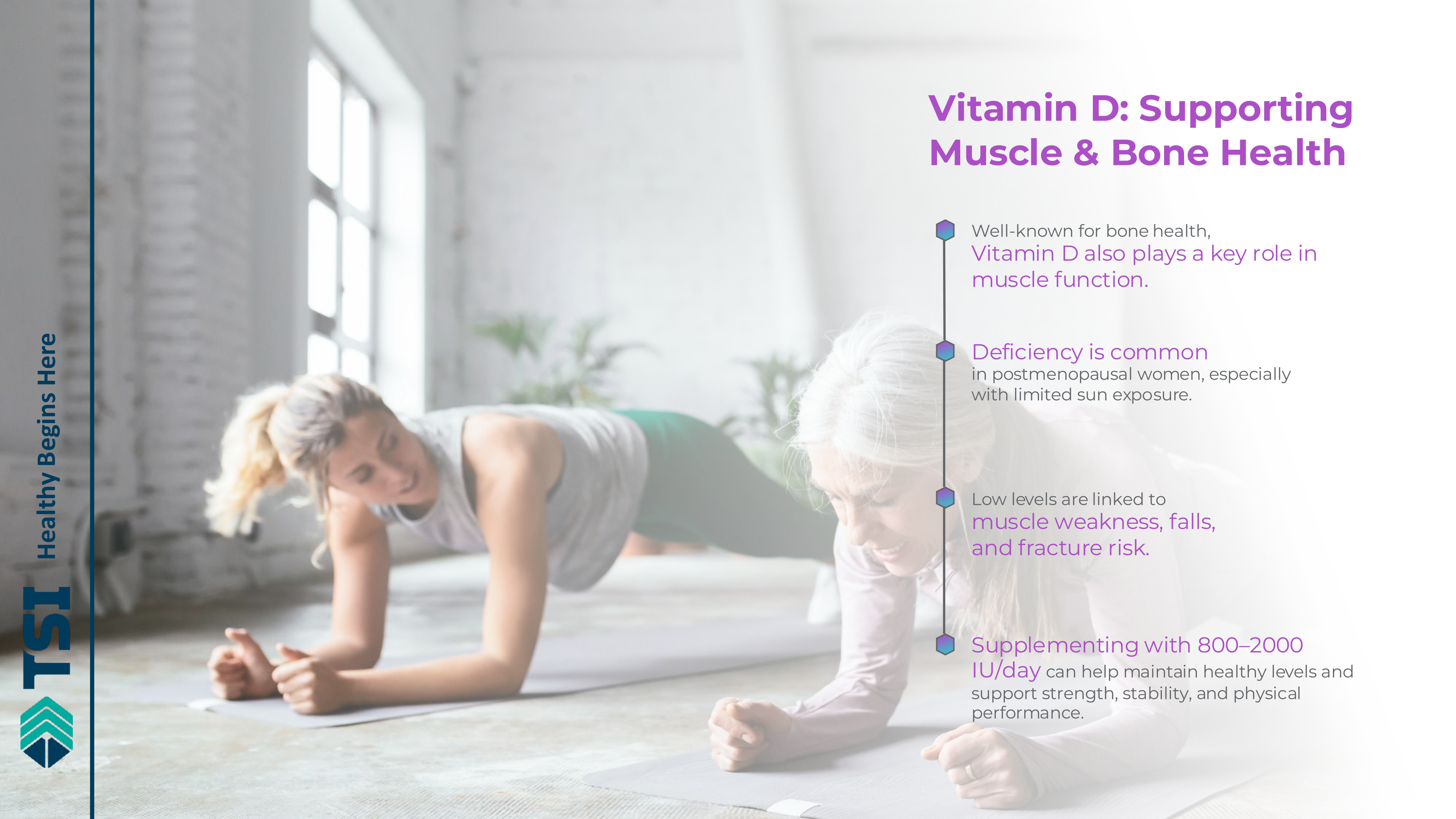
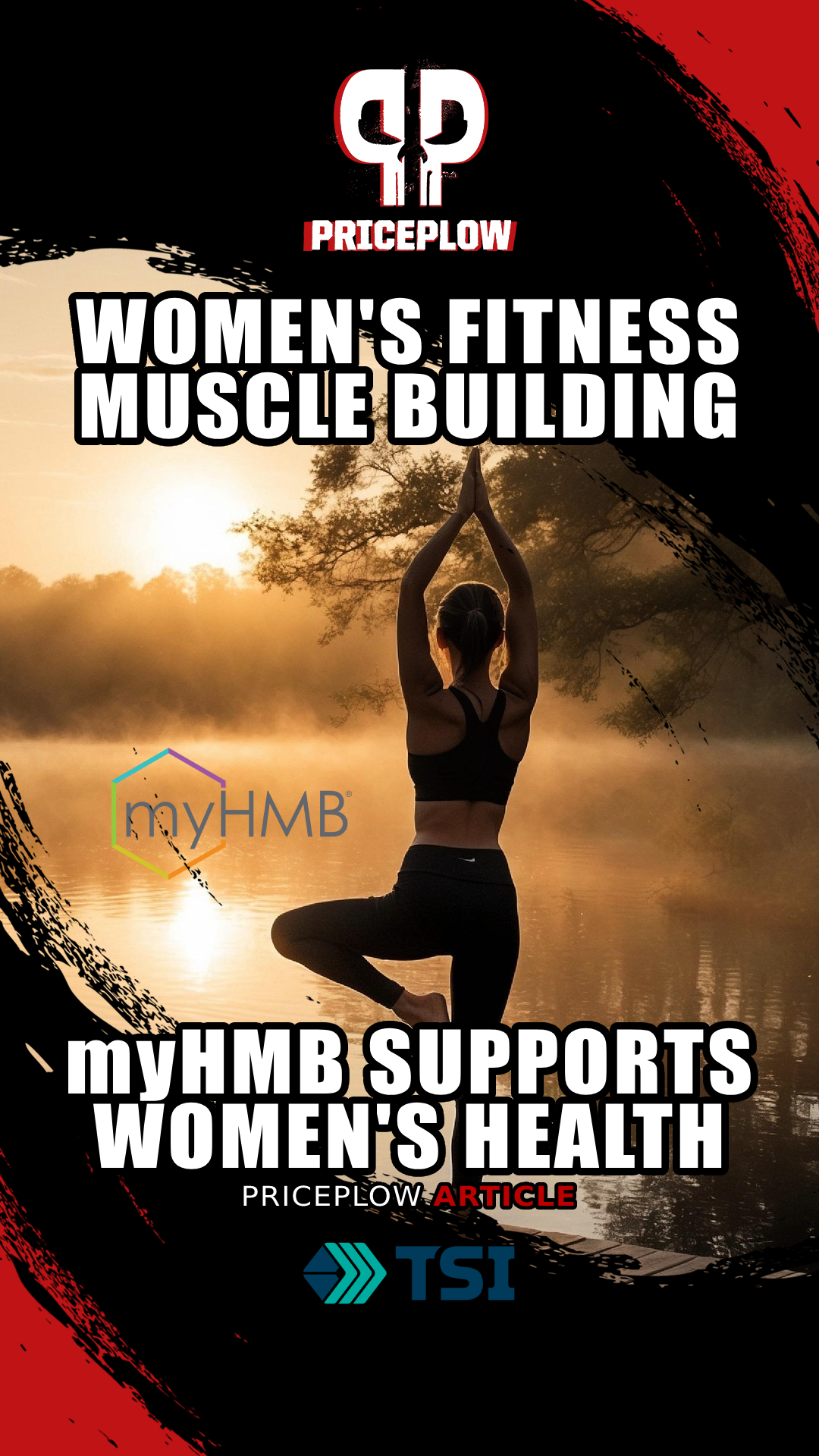

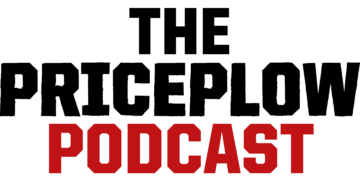
Comments and Discussion (Powered by the PricePlow Forum)